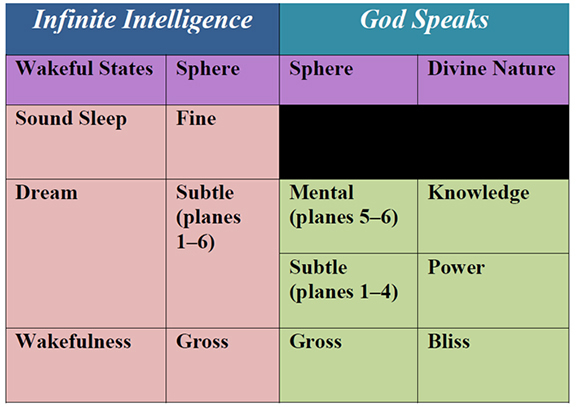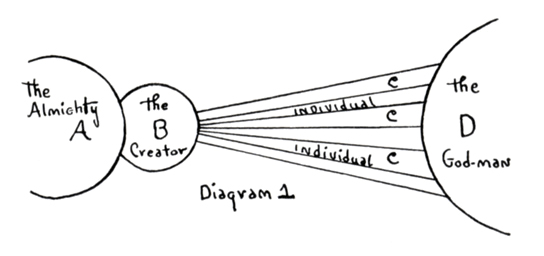Avatar Meher Baba Center Southern California
in Concert with
The Oral History Archive Project
The Creation of the Universe through Prān and Ākāsh
I. Introduction
II. Textual sources
III. Thinking and imagination
IV. The prān-ākāsh narrative
A. Larger philosophical-cosmogonic settings
B. An explanation of the narrative.
C. The accounts given in the major sources
V. Other contexts, extensions, and implications
Creation According to Genesis
1. In the beginning God created the heaven and the earth. 2. And the earth was without form, and void; and darkness was upon the face of the deep. And the Spirit of God moved upon the face of the waters.
The First Day: Light
3. And God said, Let there be light: and there was light. 4. And God saw the light, that it was good: and God divided the light from the darkness. 5. And God called the light Day, and the darkness he called Night. And the evening and the morning were the first day.
The Second Day: Firmament
6. And God said, Let there be a firmament in the midst of the waters, and let it divide the waters from the waters. 7. And God made the firmament, and divided the waters which were under the firmament from the waters which were above the firmament: and it was so.8. And God called the firmament Heaven. And the evening and the morning were the second day.
Sāmkhya
One of the six orthodox schools of classical Hindu philosophy, attributed to Kapila (perhaps 5th century BCE)
Provides much of the theoretical background to Patanjali Yoga and the Bhagavad Gita
Posits the duality of Prakriti (primordial nature or material phenomenality) and Purush (Self or Consciousness)
Prakriti is comprised of three gunas: sattva, rajas, and tamas
Correlations between the Senses and Primordial Elements as Recounted by Sankara
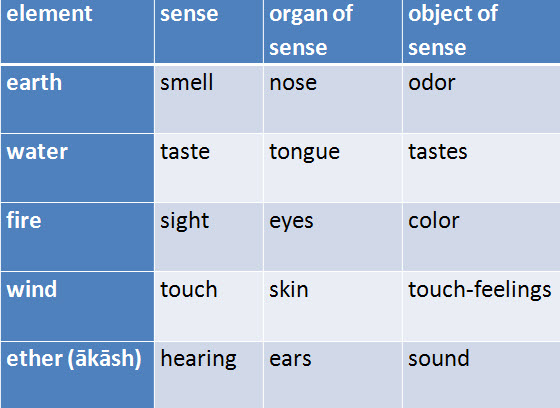
The 25 Tattvas in Samkhya
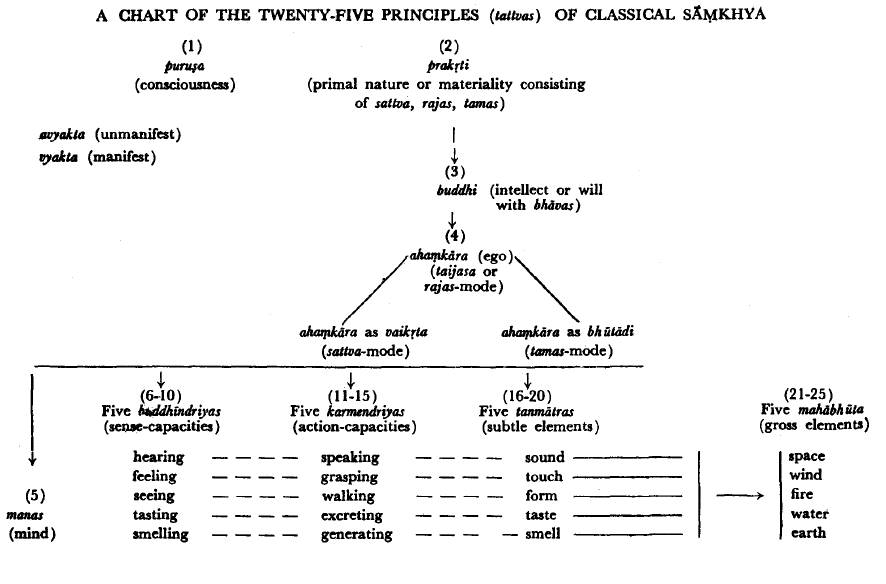
Ibn Arabi (1165-1240)
Born in Spain, Ibn Arabi migrated to the Middle East, dying in Damascus.
One of the supreme expositors of Sufi metaphysics, he is associated with “unity of being” or “Wahdat al-Wujūd.”
In God Speaks Eruch writes: “Meher Baba’s gnosis upholds without equivocation both the theory of Identityism (wahdat-ul-wujud) and the theory of Advaitism.”
Great Scientific Advances in the 1920s with Important Cosmological Implications
1.The “Big Bang” Theory. First proposed by Georges Lemaitre in 1927 and corroborated evidentially by Edwin Hubble in 1929, this theory suggests that the universe originated from a single point at a definite moment in time 13.8 billion years ago.
2.Quantum mechanics. Drawing or earlier discoveries of Max Planck and Albert Einstein, quantum theory was explicitly articulated between 1925 and 1927 through the work of Niels Bohr, Werner Heisenberg, and others.
Four Major Literary Sources on the Subject of Prān and Ākāsh
1.Infinite Intelligence, based on the “Intelligence Notebooks” (1926)
2.The “Tiffin Lecture” of 28th June 1926
3.“Shree’s Explanations on Creation and the Universe,” given to the Meher Ashram boys, December-January 1927-1928
4.“How It All Happened,” content given by Meher Baba in May 1934, and published in Early Messages to the West
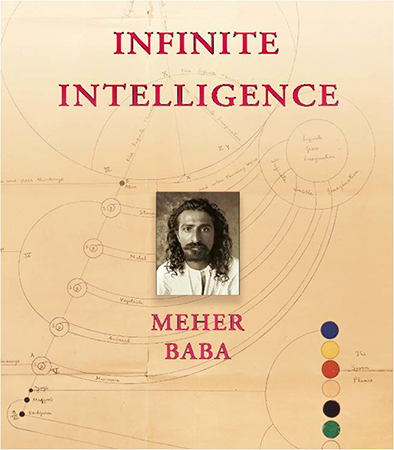
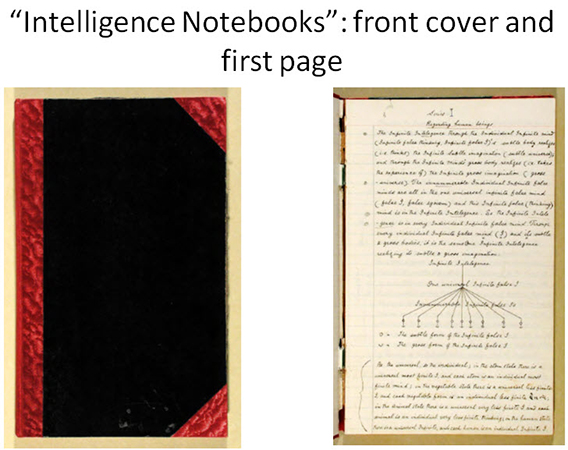


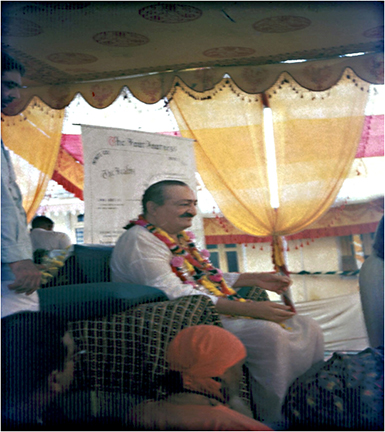
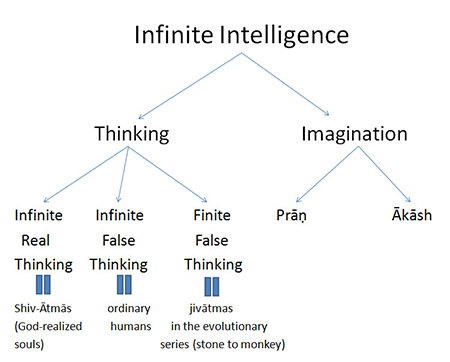
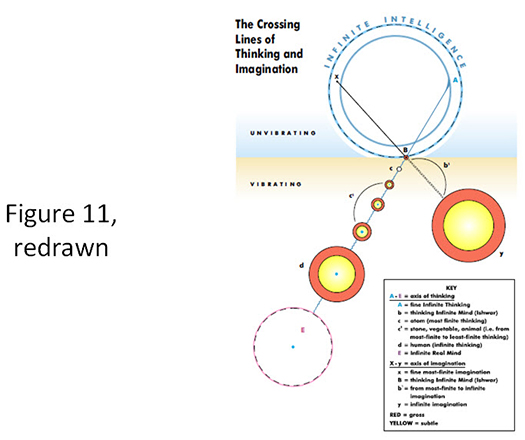
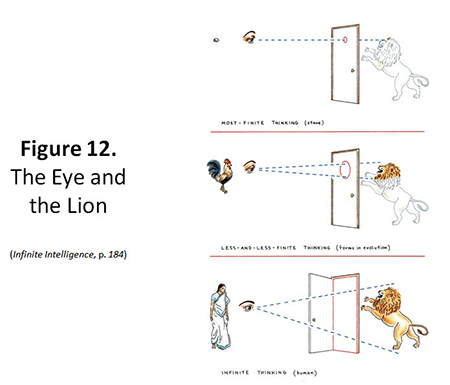
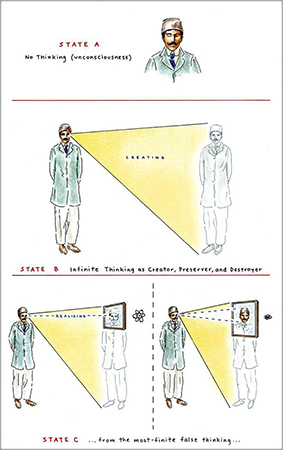
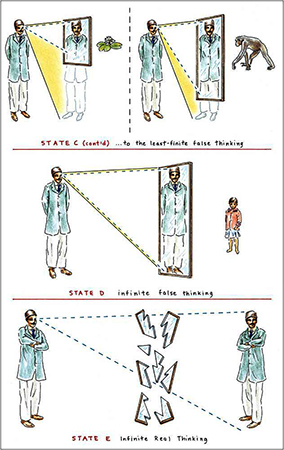
Figures 13 and 14. Jamshed’s Eye
(Infinite Intelligence, pp. 194--95)
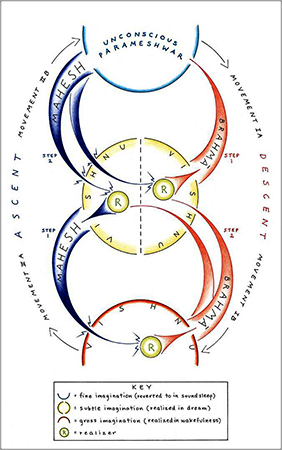
The Interplay of the Opposites
(Series 5, pp. 71-78)
| light (Prakash) is |
Darkness (Atidhakiir) is |
Intelligence |
imagination |
| Knowledge (ka/neli, "to know") |
ignorance (naka{neli,"not to know") |
| Everything |
imagination |
| Knowledge (ka/neli, "to know") |
ignorance (naka{neli,"not to know") |
| Everything |
nothing |
The Infinite (Khuda, God) |
the most finite (jag,"world") |
Paramatma (Oversoul) |
universe |
In sound sleep, Light (which is Intelligence, Knowledge, Everything, the Infinite, Paramatma or Oversoul) prevails as Light but does not see Itself as Light, and so It remains infine darkness, and indirectly as fine darkness, as it were. Intelligence prevails as Intelligence but does not think Itself as Intelligence, and so it remains in fine imagination, and indirectly as fine imagination, as it were. Knowledge prevails as Knowledge but does not know lts self as Knowledge, and so It remains in fine ignorance, and indirectly as fine ignorance, as it were. Everything prevails as Everything but does not feel Itself as Everything, and so It remains in fine nothing, and indirectly as fine nothing, as it were. The Infinite prevails as the Infinite but does not experience Itself as the Infinite, and so remains infine, utmost finitude, and indirectly as fine, utmost finitude, as it were. Paramatma (the Oversoul) remains as Paramatma but does not realize Himself as Paramatma and so remains in the fine universe, and indirectly as the fine universe, as it were.
In the ordinary awake state, Light prevails as subtle and gross darkness in the awareness of this Light. In other words, Light is experienced as darkness by Light-and here subtle and gross "darkness" means the unnatural light.t Intelligence prevails as subtle and gross imagination in the awareness of
Intelligence; in other words, Intelligence is experienced as imagination b Intelligence. Knowledge prevails as subtle and gross ignorance in the awarenes of Knowledge; i.e., Knowledge is experienced as ignorance by Knowledge Everything prevails as subtle and gross nothing in the awareness of Everything i.e., Everything is experienced as nothing by Everything. The Infinite prevails a5 subtle and gross utmost finitude in the awareness of the Infinite; i.e., the Infinite is experienced as most finite by the Infinite. Paramatma, the Oversoul, prevails as the subtle and gross universe in the awareness of Paramatma; i.e., Paramatma is
experienced as the universe by Paramatma.
In the Sadguru state, Light prevails as Light and sees Itself as such. Intelligence prevails as Intelligence and thinks Itself as such. Knowledge prevails as Knowledge and knows Itself as such. Everything prevails as Everything and feels Itself as such. The Infinite prevails as the Infinite a nd experiences Itself as such. Paramatma (the Oversoul) prevails as Paramarma and realizes Himself as such.In the ordinary awake state of ordinary human beings, the soul as Light sees darkness (the universe) as Light, that is, as Itself (this darkness, when realized as light, being the unnatural, unreal, false light);
Intelligence thinks imagination (the universe) as
Intelligence, that is, as Itself;
Knowledge knows ignorance (the universe) as
Knowledge, that is, as Itself;
Everything feels nothing (the universe) as Everything, that is, as Itself;
the Infinite experiences the most finite (the universe)
as the Infinite, that is, as Itself;
Paramatma (the Oversoul) realizes His shadow
(the universe) as Paramatma, that is, as Himself.
In short, in the ordinary human awake state, Light, Intelligence, etc., are experienced as their opposites, thus:
a) Light is experienced as darkness and darkness as
Light-by the Light;
b) Intelligence is experienced as imagination and imagination as Intelligence-by the Intelligence;
c) Knowledge is experienced as ignorance and ignorance as Knowledge-by Knowledge;
d) Everything is experienced as nothing and nothing as Everything-by the Everything;
e) the Infinite is experienced as most finite and the most finite as the Infinite-by the Infinite;
f) Paramatma is experienced as the universe and the universe as Paramatma-by Paramatma.
So in the ordinary awake state, the unlimited soul experiences itself as the body or as the universe; that is, Khuda (God) experiences Himself as the limited banda (slave). In other words, the soul-which is Light, Intelligence, Knowledge, Everything, the Infinite, Paramatma- experiences itself as darkness,
imagination, ignorance, nothing, the most finite, the universe.
The universe is nothing but darkness residing in Light; nothing but imagination residing in Intelligence; nothing but ignorance residing in Knowledge; nothing but the nothing residing in the Everything; nothing but utmost finitude residing in the Infinite; nothing but the shadow residing in Paramatma. Itself most finite, the universe resides as a drop in the infinite Ocean
of Paramatma.
SERIES 6
IMAGINATION IN THE JOURNEY FROM UNCONSCIOUSNESS TO SUPERCONSCIOUSNESS
PRAN and AKASH
When thinking (movement, vibration, consciousness) first begins, Infinite Knowledge knows ignorance; that is, Infinite Intelligence thinks that It does not think. Out of the original formless thinking emerged pran and akash. That is, as the imagination, originally in the fine formless state, became infinite subtle and gross form, pran and akash, originally joined and united in the Ahir Bindu or atom point, were split outwards
pran comprising the subtle manifestation and akash the gross. Thus pran, acting upon akash, produced the subtle and gross universes. In this way the subtle and gross universes came into being and
formlessness acquired form.
INFINITE INTELLIGENCE'S THINKING implies consciousness, movement, vibration. When Infmite Intelligence thinks that It does not think or kno"that
It does not know;It is thinking the imagination. (Here imagination can be defllled as the "does not think" and the "does not know.") It is out of such thinkingof the Infinite Intelligence that akash (space) and prai) (energy) have been produced.'
This is to say that, out of the thinking of Infinite Intelligence, the fine imagination is produced and manifested into infinite subtle and gross form. When Infinite Intelligence was not thinking, this imagination remained in its original
fine, most-finite formless (nirakar) state.
This akash and pran, which together make up the subtle and gross imagination, are manifested through the thinking, the consciousness, the movement, the vibration. This thinking is infinite, since it is the thinking of the Infinite Intelligence. Constituting the Infinite Intelligence's Infinite Mind, tl1is thinking could be further described as the Infinite Intelligence's universa lly existing thought power. It has three aspects:
1. that Mind which thinks the in1agination in the sense of creating the universe;
2. that false mind which thinks the imagination in the sense of realizing the universe;
3. that Real Mind which tl1inks Itself, that is, realizes Itself.
From Knowledge comes out knowing and from knowing has come out ignorance (which is the universe), since the Infmite Knowledge knows (or is in the state of knowing) that It does not know. This "not knowing" is ignorance, or universe, or imagination, or darkness. This "knowing that It does not know," this "not knowing," means that Infinite Knowledge acknowledges Its ignorance-in other words, realizes the universe.
Now the knowing of the Infinite Knowledge
a) creates ignorance (the universe), and
b) makes It know (or puts It in the state of knowing) Its ignorance as knowledge.
Knowing in the first sense (a) means creating the universe; and knowing in the second sense (b) means realizing the universe. This ignorance (the universe) which Knowledge acknowledges (realizes, takes the experience of) is false and imaginary; it is bhas or "seeming likeness," bhram or "delusion." Now if Knowledge be infinite, how can It be ignorant? How can Infinite Knowledge know ignorance? The answer to this lies in the fact that the universe is the
production of mere bhas, bhram; and Maya is what causes this falseness, this
imagination, this ignorance to appear as real, as thinking, as Knowledge.
So this ignorance is the imagination of the Infinite Intelligence, which Its Infinite Thinking (or creative thinking) thinks-and-creates (that is, produces); and through Its infmite false thinking (or realizing-thinking), the Infmite Intelligence thinks-and-realizes the subde and gross imagination that was the production of Its creative thinking. This imagination or ignorance is made up of pran and akash, which are manifested subdy and grossly when thinking occurs but which remain fine, most fmite, and unmanifested when creative thinking is absent. Thus the Infinite Intelligence has Infinite Thinking eternally within Itself; and this Infinite Thinking, in tum, contains eternally the imagination in its most-finite, ftne formless (nirtikar) state as atom or point. And when thinking-or consciousness, or movement, or vibration-begins, this imagination is manifested in infinite subtle and gross form. In other words, pran and akash, which in their fine state comprise the fine universe, are eternally in the Infinite Thinking of the Infinite Intelligence. And when thinking begins, pran and akash are manifested; and thus the subtle and gross universes-which are the subtle and gross infinite imagination, or the fine, most-finite imagination's infinite subtle and gross manifestations-are produced through pran acting on akash.
Pran is the subtle manifestation and akash the gross manifestation of the fine imagination. Pran means the forces produced through the thinking; when the thinking is not in force, pran exits in fine form. Akasha means "spaceless space."
The fine imagination or the fine universe is nothing but the fine unity, the
fine combination of akash and pran as one in the most-finite atom state. When thinking comes into action, this unity splits outward into infinite subtle and gross form. In other words, vibration, which is consciousness or thinking, makes the fine pran and akash, the fine imagination emerge out of the Infinite Intelligence in infinite subtle and gross form. Although the Infinite Intelligence contains Infinite Thinking (i.e., the capacity for thinking) and imagination within Itself eternally, yet when that minking- which exists within It eternally-is not at work (has not
begun, has not awoken), the imagination is not thought or produced. But when this thinking begins, the imagination is manifested in infinite form.
The Infmite Intelligence by Its thinking manufactures forth me forces called pran; and pran acting on akash creates the whole subtle and gross universe. Now fine imagination was made up of pran and akash in the fine state. That is, pran and akash, comprising the fine imagination, had been united and combined in the fine state where there was no thinking, no vibration. But when thinking began, pran acting on akash produced the universe.
When thinking begins, the fine pran and akash comprising the fin imagination are split and brought out or manifested. Thereafter this split and uncombined pran acts on the akash, forming the subtle and gross universes (imagination), the subtle being related to pran and the gross being related to akash. So the subtle and gross universes (imagination) are the productions, the forms or bodies, of pran and akash, which in their fine form had comprised the fine imagination.
To reiterate: before thinking began, pran and akash remained combined as the fine imagination. But when thinking arose, pran and akash got split up; and from pran acting on akash, the subtle and gross universe was produced. Thus the subtle and gross universe is the production of the most-finite, formless pran and akash which, in the combined state, together constituted the fine imagination of the Infinite Intelligence.
So this whole universe is mere imagination produced from the thinking of the Infinite Intelligence. Combined in their original fine formlessness, pran and akash, out of which is produced the subtle and gross universe, exist in the Infinite Intelligence as a mere most-finite atom point. From this atom point or Ahur Bindu, the Infinite Intelligence produces the infinite subtle and gross universe by means of Its thinking. The Infinite Intelligence when thinking as the Infinite Mind splits pran and akash, which had existed as fine imagination, outwards; and pran acting on akash produces the subtle and gross universe. Actually, the universe exists in the Infinite Intelligence eternally in the most-finite, fine bindu state of (the combined) pran and akash; the Infinite Mind is what manifests this fine
universe into its subtle and gross forms.
So when thinking occurs, when thinking begins, when it works and acts, the subtle and gross universe is; but when consciousness (thinking, movement, vibration) is absent, the subtle and gross universe is not. Through the most-finite atom point, the Infinite Intelligence's thinking produces or creates forth Its most finite fine imagination (the universe) into subtle and gross form. In this way the Infinite Thinking gives infinite subtle and gross form to an imagination that was originally most finite and formless. Formlessness, of course, is quite the opposite of form, and the Infinite is quite the opposite of the most finite. Thus infinite subtle and gross form is being given to its opposite-the most-finite, formless imagination-by the Infinite Thinking (or Infinite Mind) through the most-finite point or bindu or atom in the Infinite Intelligence.
Infinite Intelligence on Prāṇ and Ākāsh
Infinite Intelligence, p. 104
So false thinking has made the Intelligence subject to the limit (the universe), subject to the realization of the universe, to the upabhog of the universe. Thinking has split pran and asash and produced them forth into infinite subtle and gross form; before this thinking commenced, this same pran and akash, combined in fine state, constituted the most-finte, formless imagination. When the false I or false thinking disappears, the upabhog or the realization or experience of the universe also disappears; in other words, that limit which constitutes the subtle and gross imagination (or universe) disappears. All of this-the false thinking and its disappearance - occurs when the Infinite Intelligence is conscious as Infinite Mind.
The First Desire as the First Sanskara
(Infinite Intelligence, p. 236)
Where do all these desires come from in the first place? The first desire, the first Word, was the first sanskara.
* The first Desire, the first Word, seems to correspond to what God Speaks calls "the original whim" or 'lahar'; see esp. pp. 78-79
PURE NOTHING AND FALSE NOTHING
The "Yes"- which is Everything, Light, Knowledge, etc.- is eternal. "Yes" (Everything) can never be "No" (Nothing). This "No" exists because "Yes" exists. This "Yes" (Intelligence) manifests the "No" (Imagination).
The Everything in the Nothing state takes upon Itself the pretense of everythingness. So now the Nothing has two states: the pure Nothing, and the Nothing-pretending-to-be-Everything-that is, the pure Nothing and the false everytlling. From the "mixture" of this pure Nothing and false everything, that is, from the combination of fine imagination and false consciousness (false I or false egoism) is produced the series of evolution. This combination in its fine form is called the fine Prakriti: "nature" or "Maya" or the primordial "stuff' of creation. This Prakriti gives jiv-pana (mind state) to the Purush: the Soul or Supreme Being, which is the Infinite Intelligence.' This fine Prakriti in subtle and gross form comprises the subtle and gross body of the jiv. In brief, this combination (of fine imagination and false consciousness) makes up the jiv, which men (because of
false thinking) passes through the series of evolution from stone to human form and experiences the imagination (the pure Nothing) as the Infinite (the Everything). In other words, the unconscious or invovled Everything, evolving through the various formations from stone to human (produced from the combination of pure Nothing and Nothing pretending to be Everything) reverts to Its original Everything state - but now pocessed of Self-Consciousness.
Thus the pure Everything, caught in the net of the combination of real Nothing and false everything- that is, ensnared in the jiv or mind state with its two bodies- advances from the experience of stone form to human form, and thence on to the experience of the Sadguru, where It becomes united with Its own Real Self. In other words, the originally unconscious, formless Everything, consciously passing through the formations of Nothing, in the end becomes formless again but now as the conscious Everything. For although in the end all the formations of Nothing disappear since Nothing is, after all, just Nothing - the consciousness (the thinking, the chit, the chaitanya) that the Everything had acquired during Its passage through the formations of Nothing remains, even when these formations of Nothing themselves vanish from the scene. Thus armed with this consciousness and this thinking, the Everything now realizes and exclaims, "Oh! I am Everything. Up until now, I was passing through the bhas of the formations of Nothing. All this universe that I was realizing as the really existing Everything through the medium of the bodies (which were formations of the combination of Nothing and false everything or the false I) was actually just the non-existing Nothing, a mere product of my own imagination."
Knowledge in the beginning did not know that It was Knowledge. From this "did not know," from this Ignorance, was created the universe; and from the combination of Ignorance and false knowledge, that is, from the combination of pran-akash and false egoism, was produced or created the jiv and its two bodies. The formation of the jiv, in turn, resulted in the 8,400,000 species (eighty-four lakh yoni) through which this jiv or mind evolves. In this way Knowledge, passing through this series of the forms of false thinking, in the end comes to know Itself. In other words Knowledge, passing through the 8,400,000 species and on through the higher planes, eventually attains the
Shiv state.
Thus ignorance became the medium through which Knowledge came to know Itself. Because of ignorance (which is the nothing, the universe), Knowledge gained false knowledge. "False knowledge" means realizing the universe as real, knowing ignorance as Knowledge. In other words, when Knowledge knows ignorance yet persists in knowing that It knows, such knowing is false knowledge. Passing through the formations of this false knowledge, evolving through the 8,400,000 species and then progressing onwards through ilie higher planes, Knowledge eventually becomes really knowing. In other words,
Knowledge becomes Self-realized.


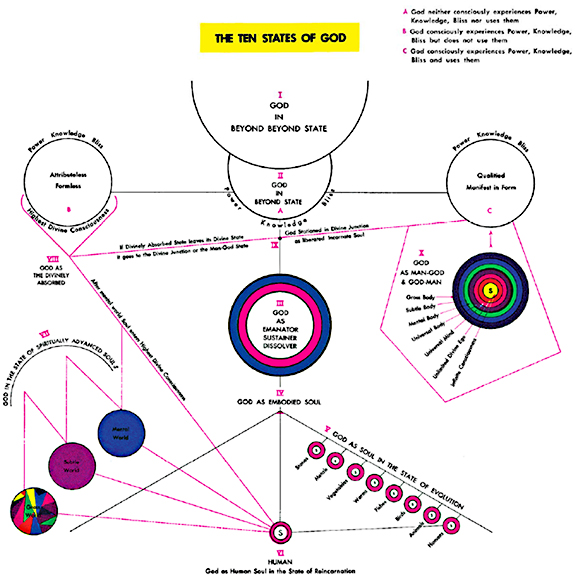
“Tiffin Lecture” of 28th June 1926
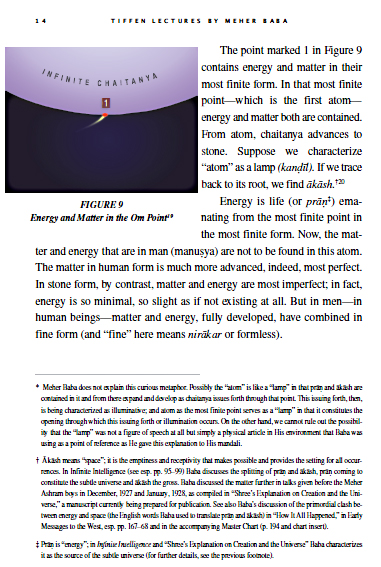
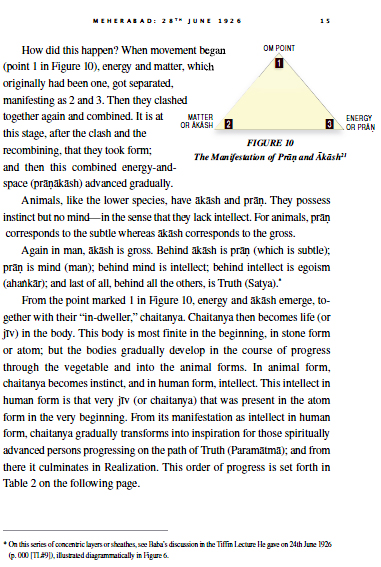
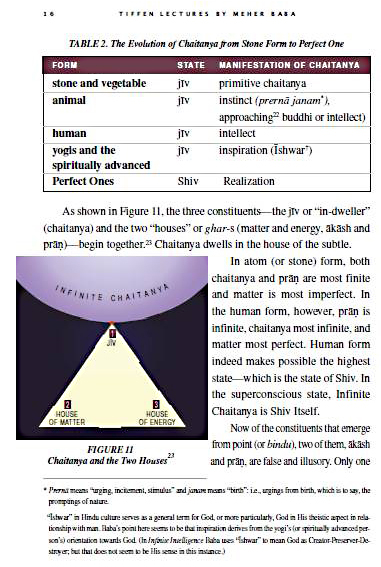
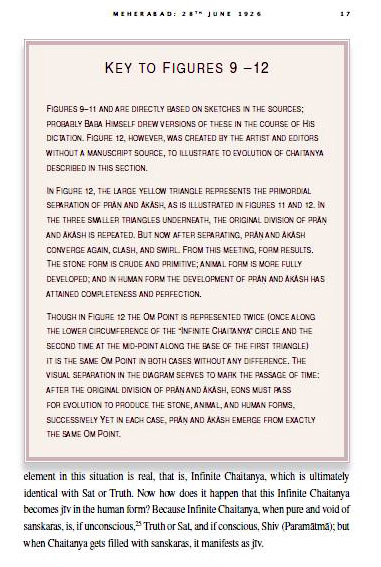
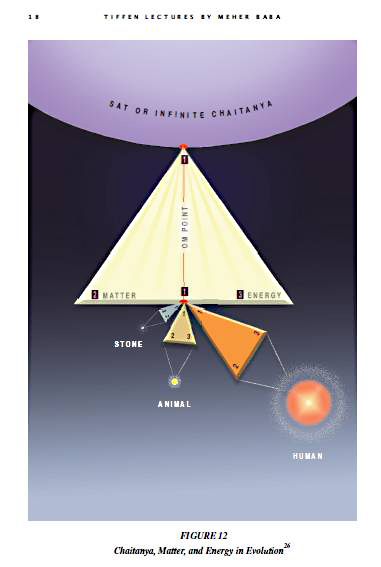
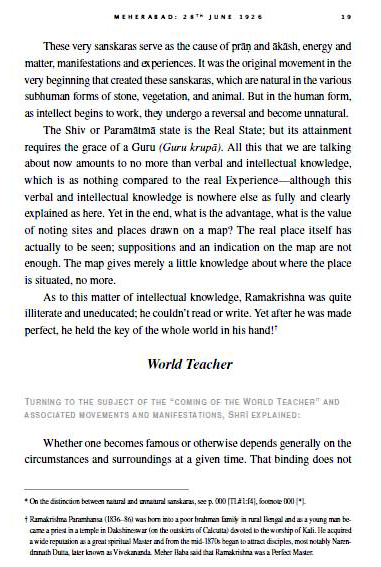
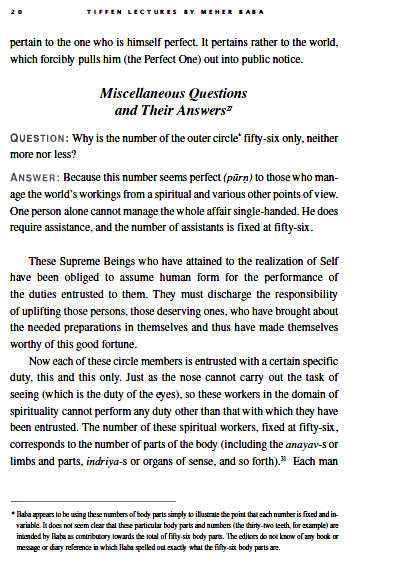
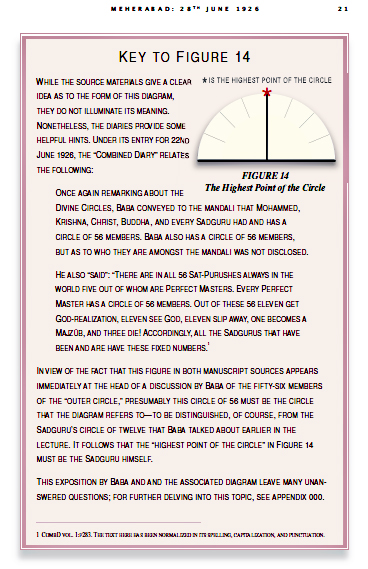
Shree's Explanations on Creation and the Universe
10 December 1927 p. 1
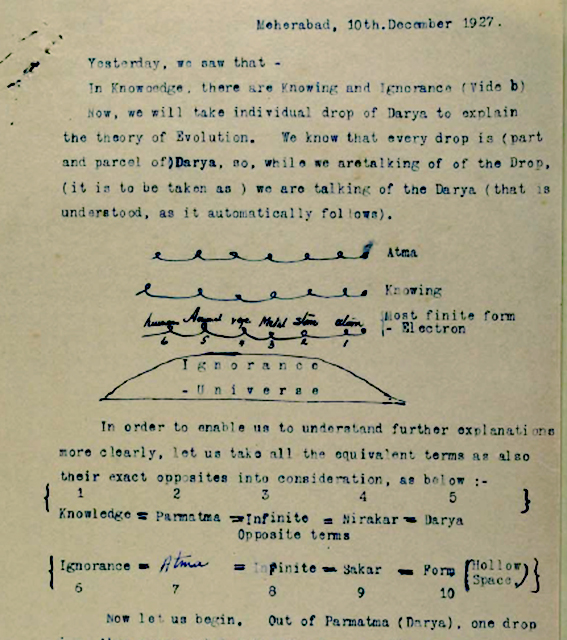
Shree's Explanations on Creation and the Universe
7 December 1927 p. 3
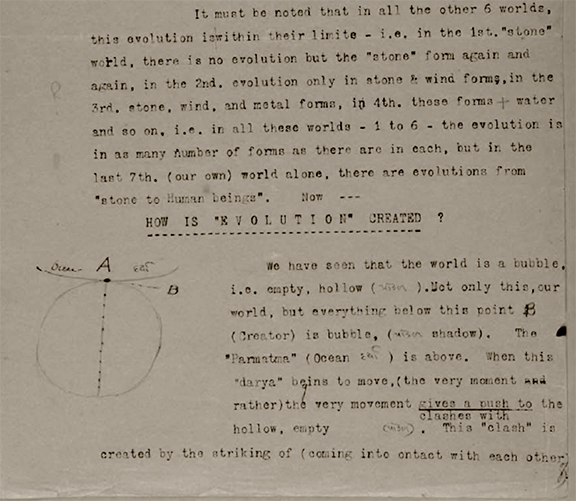
Shree's Explanations on Creation and the Universe
7 December 1927, p. 4
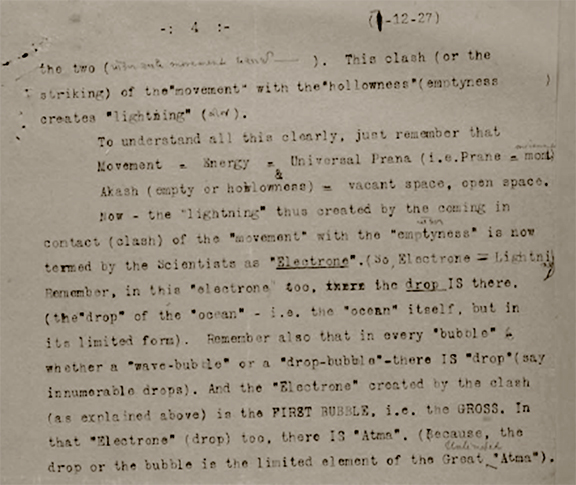
Shree's Explanations on Creation and the Universe
7 December 1927 p. 4
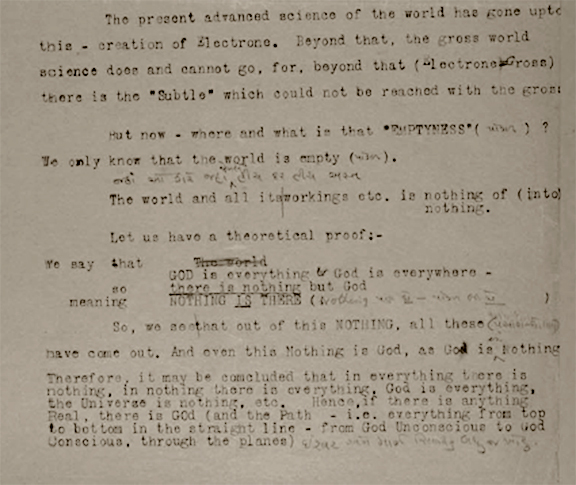
Shree's Explanations on Creation and the Universe
8 December 1927 p. 1
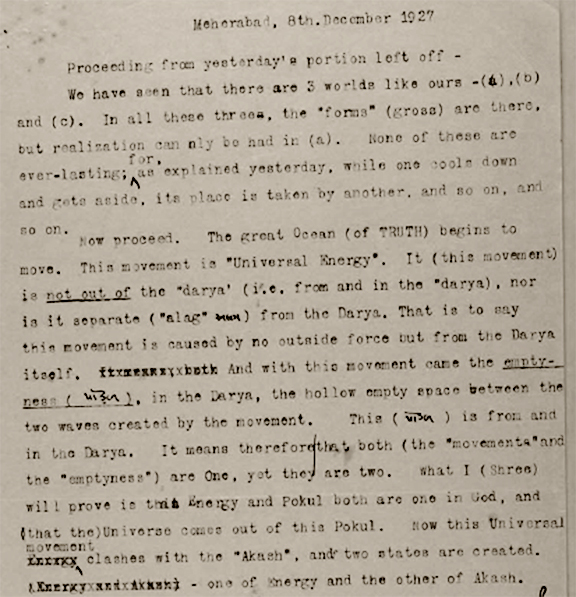
Shree's Explanations on Creation and the Universe
8 December 1927 p. 1
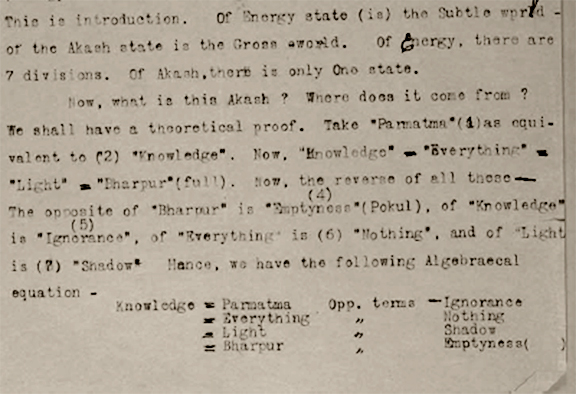
Shree's Explanations on Creation and the Universe
8 December 1927 p. 2
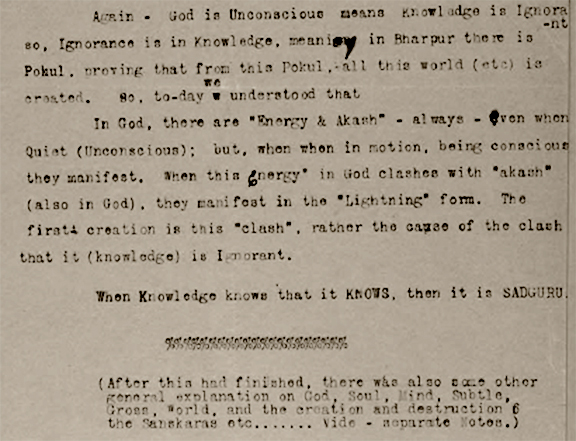
Shree's Explanations on Creation and the Universe
9 December 1927 p. 1
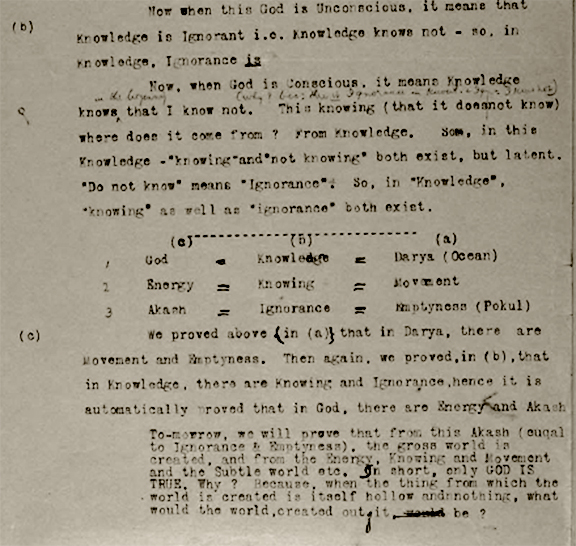
Shree's Explanations on Creation and the Universe
10 December 1927 p. 1
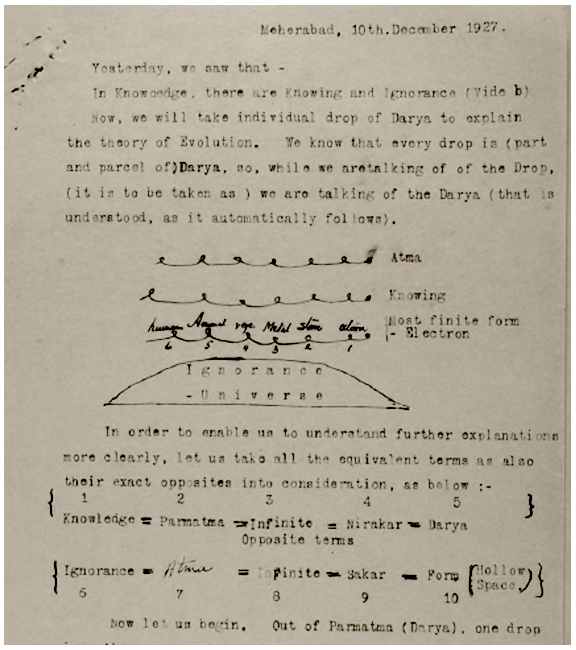
THE DEFINITION OF GOD
Chapter I
What is God? It is possible for, and indeed is the birthright of, every man and woman to realize and experience personally the One Spirit underlying the reply to this question, which can otherwise be answered in a number of ways and words.
This may appear to be empty idealism, in this so-called practical world, in which only a few care to think of and ponder over this vital question, fewer feel the Spirit underlying it, and still fewer have realized the Spirit through personal experience. But though God has been realized by only a few, the idea can never be called an unpractical ideal, inasmuch as it is possible for everyone to be spiritually perfect. To realize God is quite practical, but very, very difficult.
The above diagram is one, indivisible whole. A-B-C-D are not four different things, but one and the same without any real difference. The alphabetical letters in the diagram denote:
A = The Almighty = Paramatman = Allah.
He is One, not in the sense of half of two, but the One that remains forever One, without a second. He was always infinite, is infinite, and will always remain infinite. He is the shoreless Ocean of Truth. He is beyond time and space, cause and effect. He is beyond instinct, intellect and inspiration. But He is "unconscious," though not in the ordinary sense of the word. By "unconscious," it is meant the Almighty is in the state which may be called the Beyond-State; for it is beyond even the super-conscious state, and is unconscious of its nature. In this state, the Almighty cannot exercise His infinite powers in the mental, subtle and gross planes. In short, the Almighty does not know that He is the shoreless Ocean of Truth. He resembles the sound-sleep state.
B = The Creator = Ishwar = Khalik.
He is none other than the Almighty, the infinite Ocean of Truth, but He is conscious in one respect. He is conscious as the Creator, but not of being the
infinite Ocean of Truth that He actually is. Consequently, although He is the shoreless Ocean of Truth, He, as the Creator, does not know that He is that, and so has concern, not with A and D, but only with C, the Creation which He creates, preserves and destroys. As He is conscious of being the Creator, and not of being the Ocean, A, He is not beyond cause and effect, time and space. The creation is the effect of the cause of His consciousness; the time of the duration of His existence is one divine Cycle, and the space for His activities is the entire Creation.
C = An individual = Jivatman = Makhlook.
He is the same Almighty, and like the Creator, B, He is both conscious and unconscious. He is unconscious of His Real Self, Atman (Soul), and does not know that He is the shoreless Ocean of Truth, but He is conscious of the limited existence of, say, a drop in a bubble. Therefore, the Jivatman, too, like the Creator, B, in spite of being the infinite One, is not infinite but finite. He is not only not beyond the law of causation but is restricted by it, and is bound by space and time. His life is the effect of the cause of his consciousness. The duration of his life is as long as the divine Cycle, or till he becomes fully conscious of his Self, i.e., he realizes that he is the Almighty Himself (A).
The Jivatman, that is, life plus Soul, must lose the Jiva or life, if he wishes to become Paramatman. But losing the life does not mean ordinary dying or committing suicide. The word life is used in the sense of worldly desires. One must be free from all worldly desires, both good and bad, and their renunciation amounts to losing Jiva, or life. Desires must be done away with consciously, because desires and thoughts are sanskaras (A’mal) or mental impressions of actions, desires, and tendencies bound with egoism, in the subtle form; actions are sanskaras in the gross form. The mind uses or works out the sanskaras through the instrumentality of the subtle and gross bodies. It is because of the sanskaras that the mind is solely bent upon using them, and so the Atman finds it impossible to use the consciousness to know itself. But if the sanskaras are wiped out consciously, the Atman then would begin perceiving the Truth, and the mind will not be engrossed in external things. In other words, life must be given up while living. Otherwise Jivatman, minus Jiva, always was, is and ever will be the unconscious Almighty. The renunciation of desires of body, mind and world, while retaining the consciousness of the unconsciousness, is the goal.
In ordinary sound sleep, every Jivatman loses life (desires), but not consciously; and so he has to get up again. For the same reason, ordinary death is no death at all. It is a longer sound sleep, and one has to get up again (in another body). The ordinary death thus does not liberate the Jivatman from the chain of worldly desires. The Jivatman must die and still be living, i.e., he must become fully conscious of the pure, infinite, sexless Self, and unconscious of body, mind and the universe.
D = The Godman = Shivatman or Sadguru = Kutub.
When a Jivatman succeeds, through the network of the existence of the Creator and the creation, in knowing himself as the Almighty, (A), he becomes the Shivatman. It is then that He becomes what He really was and will ever remain, the same One Infinite Ocean of Truth — (A). For Him now, the jumble of the Creator and the creation no longer exists. He is no longer finite, and He knows Himself as the Almighty, the One Infinite Ocean that has always been in existence continuously without any change or division and will remain so forever. The Shivatman now knows that although He was in stones, metals, vegetables, trees,
birds, beasts and human beings, He was also all the time that which He is now. Thus it will be seen that the Shivatman is none else but the same One Paramatman plus knowledge and consciousness. He is the perfect wakeful state. He is Love, Lover and the Beloved. The Shivatman knows that He is in every Jivatman, and that every Jivatman is in Him. The Shivatman experiences this while the Jivatman does not. Both are the same, and yet, what a difference! The former knows that He is the All-in-All existence, that in existence He always was and will ever remain the same One Infinite Ocean of Truth; while the latter, though he is the same Ocean, does not know whence he came and where he will go.
To sum up, it is the same One Paramatman, who is playing the different parts of the Almighty, Ishwar or Creator; Jivatman or individual; and Shivatman or God-man. In the Paramatman state, the Almighty is One, Indivisible, and Infinite, "unconsciously" experiencing and sustaining Infinite Powers, Eternal Existence, Unfathomable Bliss and Universal Complete Knowledge. As Ishwar or Creator, He possesses the same powers, etc., but experiences Himself as engaged in creating, preserving and destroying the creation. As Jivatman or individual, though He is possessed of all powers, etc., He limits Himself with desires, an therefore experiences Himself as finite. But as Shivatman the God-man, and only in the state of Shivatman, does He realize all Infinite Powers, etc., in full consciousness.
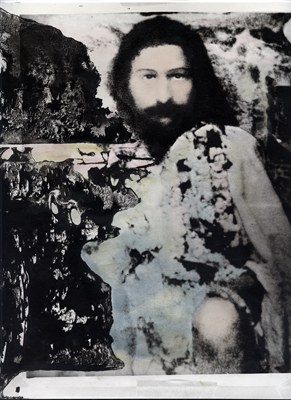
SHRI MEHER BABA
His Philosophy and Teachings
By A. K. ABDULLA
CHAPTER V
How It All Happened
There is nothing like creation in the true sense of the word. What we call creation is the manifestation of countless forms out of nothing. This nothing is really nothing, but it exists. It cannot be denied. But it is not beyond everything. Everything includes nothing, but nothing does not and never can mean everything. Before the creation manifested itself, there was literally and absolutely nothing save the Almighty, Who alone existed, but who was latently conscious, and so did not know Himself. Just as consciousness was latent in the Almighty, so this, which is called the creation, was also latent in Him. The difference between the latent and the manifested creation may be likened to that between a seed and a tree. A seed is a small particle, but if sown into proper soil and watered, it will give rise to a mighty, big tree. This means that the seed was a tree in the compact form before it was sown, and it simply manifested itself when it grew into a tree. But whether latent or manifested, whether "seed" or "tree," the creation is always nothing, as it has come out of nothing, and is made up of nothing. But the Almighty is everything, including nothing, which implies that God is but One without a second, and that the nothing is also there. The nothing is there, but the pity of it is that this nothing is felt as everything by humanity at large.
Imagine God, before the universe came into being, as the dead, still, infinite Ocean. Now just imagine a whiff of wind stirring the still waters of the Ocean.
Because of this stirring, countless different waves and drops, wave-bubbles and drop-bubbles, showed themselves out of the unity of the infinite Ocean. The whiff of wind that set the still Ocean of God into motion was but a passing fancy (what we call lahar in vernacular) on the part of the Ocean Itself to know Itself. The motion of the Ocean synchronized with this passing fancy, so that as soon as the Ocean began rolling, it began creating, or creation began manifesting itself. To put the matter more plainly, God, prompted by a passing fancy, asked Himself, "Who am I?" No sooner did He thus ask Himself than He received a shock, and no sooner did He receive a shock, than the creation that was latent, and lay in a dormant condition as the most finite and formless point in the unconscious—or latently conscious, but indivisible and infinite Paramatman—God, manifested itself in infinite forms.
The passing fancy was really a passing fancy, and not a premeditated act. The shock was simultaneous with the passing fancy and the creation synchronized with the shock; and along with the shock, the Paramatman became conscious. But He became conscious, not of Self but of the creation, because the manifestation of the creation and consciousness took place at one and the same time.
Suppose you close your eyes, and then, all of a sudden imagine you are tickled. As soon as you imagine that, at one and the same time, four different things will happen, viz: (1) you will feel that your body is being touched; (2) you will experience a mild shock; (3) you will open your eyes without any such intention, and (4) you will see something of the surroundings without the intention of seeing anything. Something like this happened when the creation manifested itself. Compare the first happening (your being touched) to the passing fancy of God; the second happening (experience of mild shock) to the shock which God received; the third happening (opening of eyes) to the consciousness which God experienced, and the fourth happening (that which you see) to the manifestation of creation. As the Paramatman uses His consciousness for knowing the creation, it follows then that for Him to use it for knowing Himself the universe must disappear; or the seeing must remain, but that which is seen must vanish.
When you are in sound sleep, you are not only unconscious of your body and the universe, but also of your very existence. When you are in the dreaming stare, you are conscious of your existence and you see various objects, dream creatures which do not really exist, but which you regard as real so long as your dream lasts. In the same way, creation exists and at the same time it does not exist.
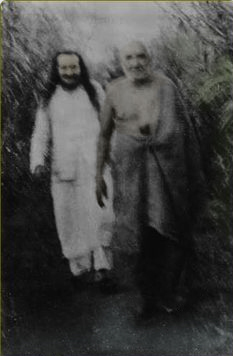

Type script of Baba’s original dictation of How It All Happened (page 1)
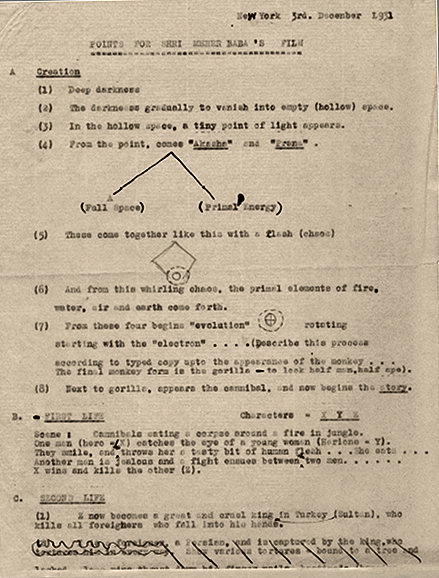
“How It All Happened”
Master Chart
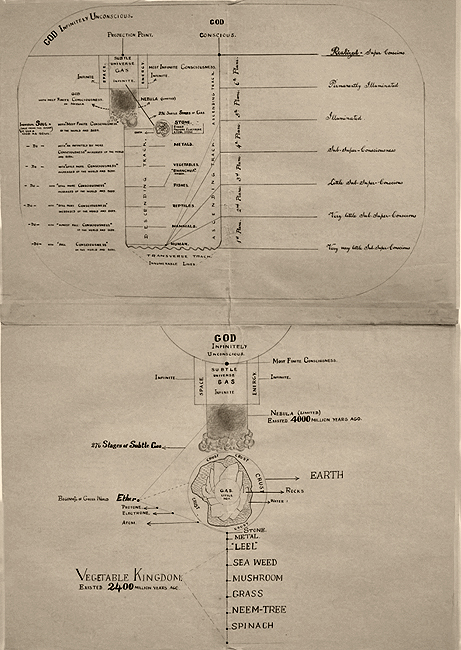
“How It All Happened,” Master Chart
(Top Left Center, on Space and Energy)
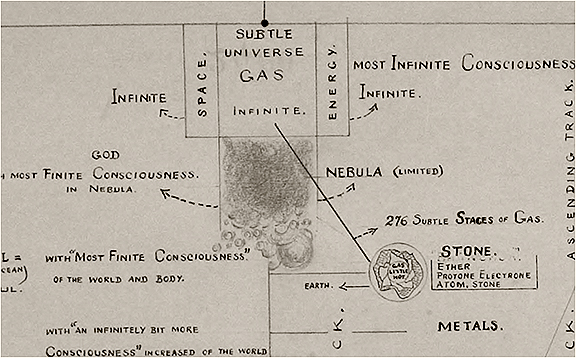
Early Messages to the West
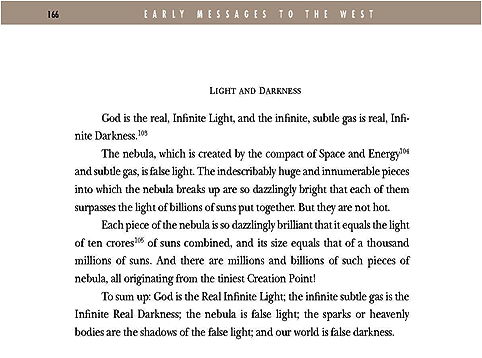
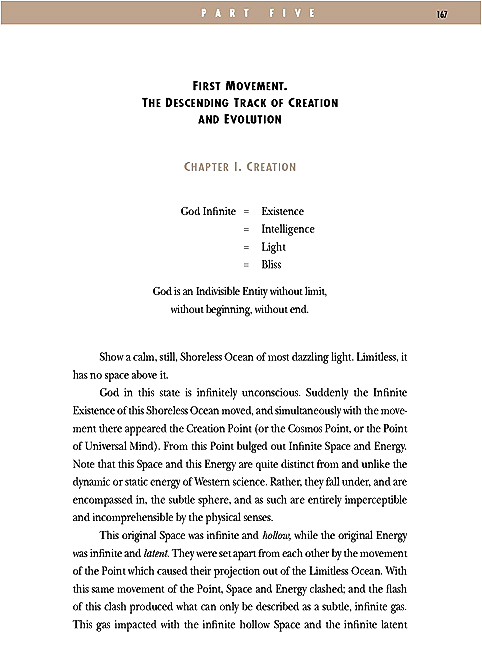
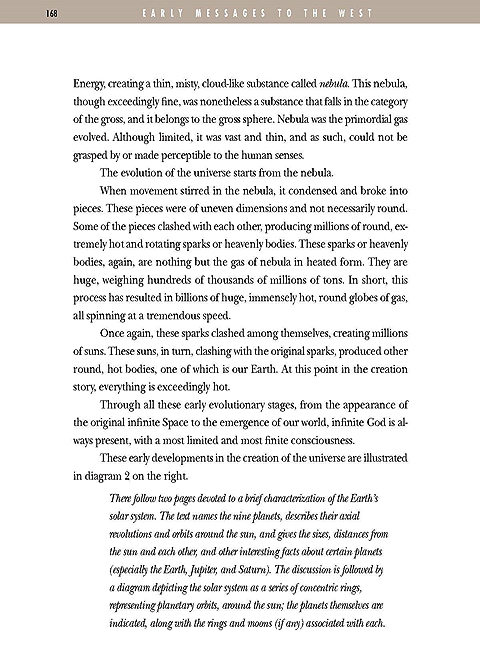
The Beginning and the End of
Creation
As long as the human mind does not directly experience Ultimate
Reality as it is, the mind is baffled in every attempt to explain the
origin and purpose of creation. The ancient past seems to be
shrouded in inscrutable mystery and the
future seems to be a completely sealed
book. The human mind can at best make brilliant conjectures about
the past and the future of the universe, because it is bound by the
spell of Maya. It can neither arrive at final knowledge on these
points nor can it remain content with ignorance about them. "Whence?" and "Whither?" are the two everlasting and poignant
queries which make the human mind divinely restless.
The human mind cannot reconcile itself to infinite regress in
its search for the origin of the world, nor can it reconcile itself to
endless change without a goal. Evolution is unintelligible if it has
no initial cause, and it is deprived of all
direction and meaning if it all does not lead
to a terminus. The very questions "Whence?" and "Whither?" presuppose the beginning and end of this evolving
creation. The beginning of evolution is the beginning of time and
the end of evolution is the end of time. Evolution has both
beginningand end because time has both beginning and end.
Between the beginning and the end of this changing world
there are many cycles, but there is, in and through these cycles, a
continuity of cosmic evolution. The real termination of the
evolutionary process is called Mahapralaya or the final
annihilation of the world, when the world becomes what it was in
the beginning, namely nothing. The Mahapralaya of the world
may be compared with the sleep of a man. Just as the varied world
of experience completely disappears for the man who is in deep
sleep, the entire objective cosmos which is the creation of Maya
vanishes into nothingness at the time of Mahapralaya. It is as if the
universe had never existed at all.
Even during the evolutionary period the universe is in itself
nothing but imagination. There is in fact only one indivisible and
eternal Reality and it has neither beginning nor end. It is beyond
time. From the point of view of this timeless
Reality the whole time-process is purely
imaginary, and billions of years which have
passed and billions of years which are to pass do not have even the
value of a second. It is as if they had not existed at all.
So the manifold and evolving universe cannot be said to be a
real outcome of this one Reality. If it were an outcome of this one
Reality, Reality would be either a relative term or a composite
being, which it is not. The one Reality is absolute.
The one Reality includes in itself all existence. It is
Everything, but it has Nothing as its shadow. The idea of allinclusive
existence implies that it leaves
nothing outside its being. When you analyse
the idea of being, you arrive by implication at the idea of thatwhich does not exist. This idea of non-existence or "Nothing" helps you to define clearly our notion of being. The complementary
aspect of Being is thus Non-Being or Nothing. But "Nothing" cannot be looked upon as having its own separate and independent
existence. It is nothing in itself. Nor can it, in itself, be a cause of
anything. The manifold and evolving universe cannot be the
outcome of "Nothing" taken by itself, and you have seen that it
also cannot be the outcome of the one Reality. How then does the
manifold and evolving universe arise?
The manifold evolving universe arises from the mixing of the
one Reality and “Nothing." It springs out of "Nothing" when this "Nothing" is taken against the background of the one Reality. But
this should not be taken to mean that the
universe is partly the outcome of the one Reality,
or that it has an element of Reality. It is an
outcome of "Nothing" and is nothing. It only seems to have existence.
Its apparent existence is due to the one Reality which is, as
it were, behind "Nothing." When "Nothing" is added to the one
Reality, the result is the manifold and evolving universe.
Reality and the
universe
The one Reality which is infinite and absolute does not
thereby suffer any modification. It is absolute and is as such
entirely unaffected by any addition or subtraction. The one Reality
remains what it was, complete and absolute in itself and
unconcerned and unconnected with the panorama of creation that
springs out of "Nothing." "Nothing" might be compared to the
value of "zero" in mathematics. In itself it has no positive value,
but when it is added to another number it gives rise to the many. In
the same way the manifold and evolving universe springs out of "Nothing"when it is combined with the one Reality.
The whole evolutionary process is within the domain of
imagination. When in imagination the one ocean of Reality gets
apparently disturbed, there arises the
manifold world of separate centres of
consciousness. This involves the basic
division of life into the self and not-self, or
the "I" and its environment. Owing to the falseness and the
incompleteness of this limited self (which is only an imagined part
of a really indivisible totality), consciousness cannot remain
content with eternal identification with it. Thus consciousness is
trapped in ceaseless restlessness, forcing it to attempt identification
with the not-self. That portion of the not-self, or the environment
with which consciousness succeeds in identifying itself, gets
affiliated with the self in the form of "mine"; and that portion of
the not-self, with which it does not succeed in identifying itself,
becomes irreducible environment which inevitably creates a limit
and an opposition to the self.
The Formation and Function of Sanskaras
The mind is constantly creating and gatheringsuch impressions in the course of its experience. When occupied with the physical objects of this world such as the body, nature and other things, the mind is, so to say, externalised, and creates gross impressions. When it is busy with its own subjective mental processes (which are the expressions of already existing sanskaras), it creates subtle and mental impressions. The question whether sanskaras come first or experience comes first is like the question whether the hen or the egg comes first. Both are conditions of each other and develop side by side. The problem of understanding the significance of human experience, therefore, turns round the problem of understanding the formation and function of sanskaras.
The sanskaras are of two types—natural and non-natural—according to the manner in which they come into existence. The sanskaras which the soul gathers during the period of organic they are created under fundamentally different conditions of life, and are, in their origin, comparatively more recent than the natural sanskaras. This difference in length of the formative periods and in the conditions of formation is responsible for the difference in the degree of firmness of attachment of the natural and non-natural sanskaras to the soul. The non-natural sanskaras are not as difficult to eradicate as the natural sanskaras which have an ancient heritage and are therefore more firmly rooted. The obliteration of the natural sanskaras is practically impossible unless the neophyte is the recipient of the grace and the intervention of a Sadguru.
As explained above, the non-natural sanskaras are dependent upon the natural sanskaras, and the natural sanskaras are a result of evolution. The next important question is, "Why should manifested life in different stages of evolution emerge out of the Absolute Reality which is infinite?” The need for manifested life arises out of the impetus in the Absolute to become conscious of itself. The progressive manifestation of life through evolution is ultimately brought about by the will-to-be-conscious which is inherent in the Infinite. In order to understand creation in terms of thought, it is necessary to posit this will-to-be-conscious in the Absolute in an involved state prior to the act of manifestation.Although for the purposes of an intellectual explanation of creation the impetus in the Absolute has to be regarded as a will-to-be-conscious, to describe it as a sort of inherent desire is to falsify its true nature.
It is better described as a lahar or an impulse which is so inexplicable, spontaneous and sudden that to call it this or that is to have its reality undone. As all intellectual categories necessarily turn out to be inadequate for grasping the mystery of creation, the nearest approach to understanding its nature is not through intellectual concept, but through analogy. Just as a wave going across the surface of a still ocean calls forth into being a wild stir of innumerable bubbles, the lahar creates myriads of individual souls out of the indivisible infinity of the Oversoul. But the all-abounding Absolute remains the substratum of all the individual souls. The individual souls are the creations of a sudden and spontaneous impulse and have, therefore, hardly any anticipation of their destined continuity of existence throughout the cyclic period until the final subsiding of the initial tremor. Within the undifferentiated being of the Absolute is born a mysterious point through which comes forth the variegated manyness of creation; and the vasty deep which, a fraction of a second before was icy-still, is astir with the life of innumerable frothy selves who secure their separateness in definite size and shape through self-limitation within the foamy surface of the ocean.
All this is merely an analogy. It would be a mistake to imagine that some real change takes place in the Absolute when the lahar of the involved will-to-be-conscious makes itself effective
by bringing into existence the world of manifestation. There can be no act of involution or evolution within the being of the Absolute, and nothing real can be born from the Absolute, as any real change is necessarily a negation of the Absolute. The change implied in the creation of the manifested world is not an ontological change or a change in the being of the Absolute Reality. It is only an apparent change. In one sense the act of manifestation must be regarded as a sort of expansion of the illimitable being of the Absolute, as through that act the Infinite which is without consciousness seeks to attain Its own consciousness. As this expansion of Reality is effected through its self-limitisation into various forms of life, the act of manifestation might with equal aptness be called the process of timeless contraction. Whether the act of manifestation is looked upon as a sort of expansion of Reality or as its “timeless contraction,” it is preceded by an initial urge or movement which might, in terms of thought, be regarded as an inherent and involved desire to be conscious. The manifoldness of creation and the separateness of the individual souls exist only in imagination. The very existence of creation or of the world of manifestation is grounded in bhas or illusion, so that, in spite of the manifestation of numberless individual souls, the Oversoul remains the same without suffering any real expansion or contraction, increment or decrement. Although the Oversoul undergoes no modification due to the bhas or illusion of individuation, there comes into existence its apparent differentiation into many individual souls.
The most original bhas or illusion into which the Oversoul was allured synchronises with the first impression. It therefore marks the beginning of the formation of sanskaras. The formation of sanskaras starts in the most finite centre which becomes the first focus for the manifestation of the individuality of the soul. In the gross sphere this first focus of manifestation is represented by the tri-dimensional and inert stone which has the most rudimentary and partial consciousness. This vague and undeveloped state of consciousness is hardly sufficient to illumine its own shape and form, and is hopelessly inadequate to fulfill the purpose of creation, which was to enable the Oversoul to know itself. Whatever little capacity for illumination consciousness has in the stone phase is ultimately derived from the Oversoul and not from the body of the stone. But consciousness is unable to enlarge its scope independently of the body of the stone, because the Oversoul first gets identified with consciousness and then through it to the stone form. Since all further development of consciousness is arrested by the body of the stone and its langour, evolution of the higher forms or vehicles of manifestation becomes indispensable. The development of consciousness has to proceed side by side with the evolution of the body by which it is conditioned. Therefore the will-to-be-conscious, which is inherent in the vastness of the Oversoul, seeks by divine determination a progressive evolution of the vehicles of expression.
Thus the Oversoul forges for itself a new vehicle of expression in the metal form in which consciousness becomes slightly more intensified. Even at this stage it is very rudimentary, and so it has to get transferred to still higher forms of vegetation and trees, in which there is an appreciable advance in the development of consciousness through the maintenance of the vital processes of growth, decay and reproduction. Emergence of a still more developed form of consciousness becomes possible when the Oversoul seeks manifestation through the instinctive life of insects, birds and animals who are fully aware of their bodies and their respective surroundings, and who develop a sense of self-protection and aim at establishing mastery over their environment. In the higher animals, intellect or reasoning also appears to a certain extent, but its working is strictly limited by the play of their instincts, like the instinct of self-protection and the instinct for the care and preservation of the little ones. So, even in animals, consciousness has not had its full development, with the result that it is unable to serve the initial purpose of the Oversoul to have self-illumination.
DIVINE THEME
Before the world of forms and duality came into existence
there was nothing but God, i.e., an indivisible and boundless ocean
of Power, Knowledge and Bliss. But this ocean was unconscious
of itself. Picture to yourself this ocean as absolutely still and calm,
unconscious of its Power, Knowledge and Bliss and unconscious
that it is the ocean. The billions of drops which are in the ocean do
not have any consciousness; they do not know that they are drops
nor that they are in the ocean nor that they are a part of the ocean.
This represents the original state of Reality.
This original state of Reality comes to be disturbed by an urge
to know itself. This urge was always latent in the ocean; and when
it begins to express itself, it endows the drops with individuality.
When this urge makes the still water move, there immediately
spring up numerous bubbles or forms around the drops; and it is
these bubbles which give individuality to the drops. The bubbles
do not and cannot actually divide the indivisible ocean; they cannot
separate the drop from the ocean; they merely give to these
drops a feeling of separateness or limited individuality.
Atma in Reality Is Paramatma
In order to clarify the relationship of “atma-Paramatma” we compare Paramatma with an infinite ocean, a limitless ocean, and the
atma as a drop in this ocean. The atma is never out of this limitless
ocean (Paramatma).
The atma can never be out of Paramatma because Paramatma is
infinite and unlimited. How can the atma come out of, or have a
place beyond, the limitlessness of the limitless? Therefore the atma
is in Paramatma.
After establishing the primary fact that the atma is in Paramatma
we go a step further and say that atma is Paramatma. How?
For example, let us imagine an unlimited ocean. Let us also
imagine that we separate or take out one iota of ocean from the limitless In other words, the infinite, unlimited and limitless ocean itself
is now looked upon as merely a drop of that infinite, unlimited and
limitless ocean. And in comparison to that infinite, unlimited and
limitless ocean this iota of ocean, or this drop of the iota of ocean,
is most finite and most limited with infinite limitations. That is, the
infinitely free iota finds itself infinitely bound.
Similarly, the atma, which we have compared with a drop of
the infinite ocean, obtains a seeming separate existence, though in
reality it can never be out of the limitlessness of the limitless, infinite
Paramatma which we have compared with the infinite, unlimited
and limitless ocean.
But just as the iota of ocean acquires its limitation as a drop
through being in the form of a bubble on the surface of the ocean, and
the bubble bestows upon the iota of ocean an apparently separative
existence from the infinite ocean, likewise the atma, which is in
Paramatma and is Paramatma, apparently experiences separative
existence from the infinite Paramatma t h rough the limitations of
a bubble (of ignorance) with which the atma shrouds itself. No
sooner does the bubble of ignorance burst, than the atma not only
finds itself in Paramatma but experiences itself as Paramatma.
Through this limitation, formed by the bubble of ignorance,
self-created by the atma, the atma apparently inherits a separative
existence from Paramatma. And because of this self-created separativeness
from infinite Paramatma, the atma, which is itself infinite,
unlimited and limitless, apparently experiences itself as most
finite with infinite limitations.
Part 2
The Initial Urge and the Journey of
Evolving Consciousness
Let us now think of one unconscious soul.
In the beginning the soul had no impressions (sanskaras) and
no consciousness.
T h e re f o re at this stage or in this state, the soul had no gross
form or body, subtle body or mental body, because only the existence
of gross, subtle and mental impressions (sanskaras) can
give existence to gross, subtle and mental bodies, and only the
existence of these bodies can make possible the existence of gross,
subtle and mental worlds.
Hence in the beginning the soul had no consciousness of gross,
subtle and mental bodies and was also unconscious of its own self,
and the soul then naturally had no experience of the gross, subtle
and mental worlds and also had no experience of the Over-Soul
(Paramatma).
This infinite, impressionless, unconscious tranquil state of the
soul reverberated with an impulse which we call THE FIRST URGE
(the first urge to know Itself).
The first urge was latent in Paramatma.
When we compare Paramatma to an infinite, unlimited ocean
and when we say that Paramatma got the first urge, it could also be
said in terms of comparison that the infinite, unlimited ocean got
the first urge or THE WHIM.*
In the Infinite, both finite and infinite are included.
* [See also Meher Baba, “The Whim from the Beyond,” Beams from Meher Baba on the
Spiritual Panorama (San Francisco: Sufism Reoriented, Inc.)
Now was this first urge infinite or finite, and was it at first finite
and then infinite or vice versa?
The first urge was most finite, but this first urge was of the Infinite.
This most finite first urge was of the infinite Ocean-Paramatma,
and the manifestation of this latent most finite first urge of the Infinite was restricted to a most finite point in the infinite, unlimited Ocean.
But as this most finite point of manifestation of the latent first
urge, which was most finite too, was in the infinite, unlimited Ocean, this most finite point of manifestation of the first urge was also unlimited.
Through this most finite point of manifestation of the first urge
(also most finite), the shadow of the Infinite (which shadow, when
of Reality, is infinite) gradually appeared and went on expanding.
This most finite point of manifestation of the latent first urge is
called the “Om” Point or Creation Point and this point is unlimited.
Simultaneously with reverberations of the first urge, the most
gross first impression emerged, objectifying the soul as the most absolute
opposite and most finite gross counterpart of the Infinite.
Because of this most gross first impression of the first urge, the infinite
Soul experienced for the first time. This first experience of the
infinite Soul was that it (the Soul) experienced a contrariety in its
identity with its infinite, impressionless, unconscious state.
This experience of contrariety effected changeableness in the
eternal, indivisible stability of the infinite Soul, and spontaneously
there occurred a sort of eruption, disrupting the indivisible poise
and the unconscious tranquility of the infinite Soul with a recoil or
tremendous shock which impregnated the unconsciousness of the
unconscious Soul with first consciousness of its apparent separateness
from the indivisible state of Paramatma. But the Soul
being infinite, the first consciousness that it derived from the recoil or shock of an absolutely opposite and most gross first impression of its apparent separateness was naturally and necessarily
finite first consciousness.
The sense to be conveyed is that the shadow of the Infinite seeped through or oozed
out of the most finite point
expanse of this unlimited ocean. It follows then that this iota
of ocean, while in the limitless ocean, before separation is ocean
itself, and is not there in the shoreless ocean as an iota of the ocean,
because every iota of ocean, when not limited by the limitations
of a drop, is unlimited ocean.It is only when an iota of ocean is separated from the unlimited
ocean, or is taken out of the unlimited ocean as a drop, that this
iota of ocean obtains its separate existence as a drop of the shoreless ocean, and that this iota of ocean begins to be looked upon as a drop
of the unlimited ocean.
This first consciousness derived by the Soul is obviously most,
most finite in proportion to the experience of the absolute opposites
of its own original infinite state.
It then means that in the beginning, when the impressionless
infinite Soul was first impressioned, it got as its first impression an
absolutely gross impression. And the first consciousness it (the
Soul) derived was most, most-finite.
Simultaneously at that instant, the unconsciousness of the infinite
Soul actually experienced most, most-finite first consciousness
of the most-gross first impression.
This infinite and eternal Soul did get consciousness, but this consciousness
by impression was not of its eternal state or its infinite
Self but was of the most-finite, by the most-gross impression .
Now as will be explained later, if the soul is conscious of impressions (sanskaras) then the soul must necessarily experience these impressions, and in order to expereince the impressions
the consciousness of the soul must experience them through proper media.
As the impressions are, so are the experiences of impressions
and so must be the media to experience the impressions. That is, the
impressions give rise to experiences, and to experience the impressions
the use of appropriate media is necessitated.
Therefore as the infinite, eternal and formless Soul now has the
most, most-finite first consciousness of the most, most-gross first impression, quite obviously and necessarily this most, most-finite first
consciousness of the soul must utilize the most, most-finite and
most, most-gross first medium to experience the most, most-gross
first impression.
At this stage it suffices to mention here for the limited human
understanding that the most, most-finite first consciousness of the
soul, while experiencing the most, most gross first impression, centred itself in an appropriate most, most-finite and most, most gross medium, imperceptibly tending the Soul (without form) to associate
and identify its very infinite, eternal Self with this most,
most - gross and most, most-finite limited form as its first medium.
The first consciousness of the indivisible Soul, experiencing the
first impression through the first medium, creates a tendency in the soul to associate and identify its eternal, infinite Self with the first
form, the most-finite and most-gross, which was as the seed of the
contrariety, spontaneously sown by the reverberations of the first
urge, imperceptibly germinated and manifested, for the first time,
in the shape of duality.
When it is made to associate and identify itself,
by its newly gained consciousness, with the finite, gross form
or medium, the consciousness of the soul actually makes the infinite,
eternal, indivisible Soul without form experience that it is
that finite, gross form.
Thus the consciousness gained by the unconscious soul, instead
of experiencing reality t h rough unity and identity with the
Over-Soul, experiences illusion through duality and identity with
the gross form, multiplying diverse, innumerable impressions in
a series of experiences while associating with the gross form and
gradually gaining or evolving more and more consciousness.
In order to understand more clearly and concretely how the
consciousness gained by the soul gradually develops through the
p rocess of evolution, let us examine that state of the conscious soul
where the consciousness of the soul associates itself with stone form
as the most-finite and most-gross medium, and the soul thus
begins to identify itself as stone.
Actually the consciousness of the soul utilizes the stone-form
only after innumerable cycles and ages of diverse experiences
through diverse species of forms, of which there are seven major
different kinds of most, most-finite and most, most-gross gaseous
forms, which cannot even be concretely grasped nor imagined by
ordinary human beings.
It is for convenience that we begin with that state of conscious soul when it just begins to associate and identify itself with stone-form.
In stone-form, too, there are varied species, and the consciousness
of the soul has to utilize each and all of these species
as appropriate media, one after the other, in accordance with the
diversity of impressions of the soul, to experience varied and
countless impressions gathered one after the other in stone-form.
If we take stone as a medium for most-gross impressions, it follows
that the soul, which is eternally in the Over-Soul, now withmost-finite consciousness experiences most-gross impressions
through the medium of stone-form.
It is thus that the infinite, indivisible, eternal soul (without
form) which is eternally in the Over-Soul, while experiencing the
most-finite gross impressions through its own most-finite consciousness,
utilizes the most-finite gross medium of the first-most
species of stone (“first-most” meaning the very, very first), and the
soul is thus imperceptibly, though spontaneously, made to identify
itself as stone.
Part 8
The Beyond the Beyond State of God,
the First Urge and the Cycle of Evolution
and Involution of Consciousness
The Beyond the Beyond State of God
To begin with the beyond the beginning, there is the original
state of the Beyond the Beyond state of God or Paratpar Parabrahma.
This is the original state of “GOD-IS.” In Sufi t e rms this state is said
to be the state of Wara-ul-Wara.
In this original state of “God-Is” unbounded absolute vacuum
prevails.
In this absolute vacuum there is neither any manifestation of
the conscious or unconscious state of God nor is there manifestation
of the consciousness or unconsciousness of God. Neither is
t h e re the unlimited “I”—the Divine Ego or the Universal Ego—nor
is there the limited “I” or the individual ego. Neither is there universal
mind nor is there limited mind. Neither is there unbounded
energy nor is there limited energ y. Neither is there the universal
body—the mahakarana sharir—nor is there the limited body. Neither
are there universes nor are there worlds. There is not even consciousness
of either the consciousness—mahachaitanya —or of the
unconsciousness.
This state is absolutely the original unbounded absolute vacuum
state of God—neither the nirguna-nirakar, nor the saguna-sakar states of God—where “God-Is” and “consciousness is-not.”
When it is said, “God-Is,” it describes the state which prevails
beyond the beginning of the beginning of Creation.
This state of God-Is is also called the “original divine sound
sleep state of God” in the Beyond the Beyond state.
The God-Is state is the state of infinitude. Infinitude by virtue
of being infinite is everything. That is, “ EVERYTHING” is the nature
of infinitude.
EVERYTHING by virtue of being everything embodies even
“NOTHING,” or else Everything can never mean everything. This
Nothing is latent i n the Everything. But Nothing, being literally
nothing, the very being of being nothing is nothing at all.
As this Nothing is latent in the Everything, the Nothingness
of the Nothing is embedded in the Everything as the Latency.
Thus, in the infinitude of the God-Is state all that is latent in
the nature of Infin i t y, which is Everything, is the Nothing. Therefore
anything that is latent in Everything is of the Nothing.
In short, except for the infinity of the infinitude, all things are
latent in the God-Is state of Everything; and all that is latent is of
the Nothing with all its aspects as Nothingness.
In the God-Is state where the Nothing is latent, automatically
by the nature of nothingness, consciousness also exists as Nothing.
Accordingly consciousness in the Beyond the Beyond state of God
is ever and ever latent in God Who is by nature the EVERYTHING—
infinite and unlimited and unbounded. Thus automatically, by His
very nature of being the Everything, God in the God-Is state has in
Him ever and ever infinite power, infinite knowledge, infinite bliss
and all that is infinitely glorious or beautiful.
Because God is the Everything and the Infinite, the opposite of
the Everything, which is the Nothing, must be most finite.
Therefore the Nothing is latent in the God-Is state as the most
finite; or, in the infinite state of God which is the Everything there
is latent the most finite state of the Nothing.
It is only natural that when this latent and most finite Nothing
manifests, it ought to manifest as most finite.
But it is a most paradoxical fact that when this most finite Nothing
manifests, its manifestation gradually expands ad infinitum.
The thing that gives infinity to this most finite Nothing is
God’s own latent trio-nature of infinite power, infinite knowledge and infinite bliss which, by virtue of being the nature of God, obviously
pervades the infinitude of the God-Is state latently. Naturally, this infinite trio-nature also envelops this most finite Nothing
when latent in the infinity of the Everything “Om” Point.
Therefore, when this most finite Nothing becomes manifested
as Nothingness, the manifestation of the most finite Nothing closely
linked with, and stretched forth by, the simultaneous projection of the latent all-pervading infinite trio-nature of God, gradually
expands ad infinitum and gets apparently manifested as infinite
Nothingness or the Creation; and hence the universe of Nothingness
which is illusory can be called God’s “shadow” and, God being
infinite, His shadow is also infinite.
When it manifests, the Nothing, which is most finite and latent
in the Everything, projects out from a most finite point in the Everything
where the Nothing as most finite is embodied.
The most finite point from where the Nothing projects out as
Nothingness is called the Creation Point or the Om Point. This creation
point is naturally also in the Everything, which means in God
in the Beyond the Beyond state.
So the most finite Nothing projects as the Creation out of the
infinite Everything hrough the most finite “creation point,” into
the infinity of the infinitude of the God-Is state.
In short, when the most finite Nothing gets projected as Nothingness
through the most finite creation point, which is also in the
infinity pervaded by the infinite trio-nature of God, the projection
of the most finite Nothingness—closely linked with and upheld by the all-pervading infinite trio-nature of God—gradually expands
ad infinitum and manifests apparently as infinite Nothingness or
as infinite Creation
(*The whole Creation has come out of the Nothing. Out of the Nothing two things
have emerged, evolution and production. Out of the Nothing, seven states of gas
came into being. The seventh evolved state is hydrogen. Out of this seventh gaseous
state evolution and production came into being.
*Creation can be reconciled with evolution because all is in seven stages: seven
stages of production, seven stages of evolution, and seven stages of involution.
So, it is said that God created the universe in seven days. From the Nothing, most
finite shadow and infinite shadow emerged simultaneously.)
The Whim or Lahar
The cause which led the most finite Nothing, latent in the infinite
Everything, to manifest itself as infinite Nothingness, is the
original cause called the “CAUSE.”
This Cause is just nothing but the WHIM or lahar of God. This
original whim can also be called the first “WORD” uttered by God—
“WHO AM I?”
The infinitude of the God-Is state made God absolutely independent,
and by virtue of being absolutely independent it is but
natural for God to exercise His infinite whim to experience and
enjoy His own infinity. To exercise a whim is always the mark of
an independent nature, because it is whimsicality that always
colours the independent nature.
It is the original infinite whim which is responsible for giving
Cause to the latent-all that was of the Nothing to manifest as
Nothingness .
But before God exercised His original infinite whim to make
manifest the latent-all that was of the Nothing, this whim of God
was itself latent as the Nothing in the Everything of the infinitude
of absolutely independent God in the God-Is state.
How is it then possible for the latent original infinite whim to
surge in God and make manifest itself and all that is latent of the
Nothing as Nothingness?
Whim after all is a whim; and, by its very nature, it is such that
“why—wherefore—when” can find no place in its nature. A whim
may come at any moment; it may come now or after a few months
or after years, and it may not come at all.
Similiary, the original infinite whim, after all, is a whim, and
too, it is the whim of God in the state of infinitude! This whim
may not surge in God at all; and, if it surges, either at any moment
or after thousands of years or after a million cycles, it need not be
surprising.
Thus it is, that the original infinite whim of God in the state
of infinitude once surged; and it surged both spontaneously and all
of a sudden in absolutely independent God Who is eternally Eternal.
Hence this whim, which once surged, once began the Beginning
of all things in Creation.
In short, this original infinite latent whim of God in the state of
infinitude, once it surged in God Who is absolutely independent,
made itself manifest, and simultaneously with its manifestation,
it manifested the latent-all that was of the Nothing as Nothingness. Thus the whim created the nothing.
Let us recapitulate how infinite Nothing came out of most finite
Everything:
God Beyond is infinite Everything. Infinite Everything may be
compared to an infinite, limitless ocean. Therefore this limitless
ocean is infinite Everything. Thus every drop in the ocean is most finite
Everything. In short, if infinite ocean is infinite Everything then
every drop of the ocean is most finite Everything.
Before the whim surges in the limitless ocean and before Creation
is manifested, the creation point (Om point) through which the
Creation is ejected is itself in the limitless ocean as infinite Everything
because, prior to the surging of the whim, perfect tranquility
prevailed and pervaded the limitless ocean; there was no question
of “drops” of the ocean and there was no separateness. There was
limitless ocean as infinite Everything.
At the instant when the whim surged in the infinite Everything
the creation point or Om point manifested as most finite Everything.
Infinite Nothing was latent in the infinite Everything, but when
the whim surged the infinite Nothing got manifested through most
finite Everything, which is the Om point.
Thus, through the most finite Everything, the infinite Nothing
is ejected gradually, manifesting itself as expanding ad infinitum.
Simultaneously with the projection of the latent Nothing and
with the manifestation of Nothingness, the consciousness which
existed as Nothing, latent in the infinitude of the God-Is state,
also got projected and manifested itself gradually as the consciousness
of God, and made God experience Himself as God the Creator of all the things that projected out of His state of the Every t h i n g
as Nothingness.
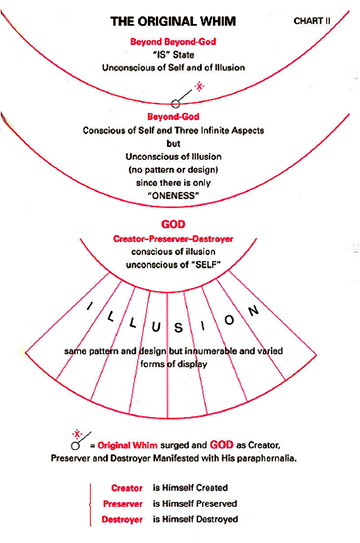
Whereupon, gradually gaining full consciousness, God in the
state of Creator became entangled in the maze of most-finite Nothingness
found as infinite, stretched out and upheld through His
own infinite trio-nature.
The paradoxical irony is that the infinity itself of God makes
it infinitely difficult for God to escape the false apparent infinity
of Nothingness which goes on expanding ad infinitum through
the closely linked infinite trio-nature of God which is infinite
power, infinite knowledge and infinite bliss.
But this entanglement is absolutely necessary in order that
God in the infinitude of the God-Is state should gain consciousness
fully and completely for Himself and of His infinite reality,
and in this way experience consciously His unbounded, unlimited,
infinite trio-nature of infinite power, infinite knowledge and
infinite bliss.
The fundamental fact is that full consciousness once gained
can never be lost. It remains eternally, regardless of whether that
consciousness fully gained is the consciousness of the false Nothingness
experienced as real, or whether that consciousness is the
consciousness of Reality Itself.
Eventually consciousness does make God realize His own reality
after that same consciousness has attained complete maturity.
Consciousness is fully matured to realize Reality only after it is nurtured by the apparent awareness of the false. This awareness of the
false as real becomes so intensified during the course of the evolution
of consciousness, that the consciousness, steeped in false
awareness, makes God aware only of the false, which is experienced
by God as the real. That is, God as Creator falsely experiences
the manifestation of the Nothing as real and Everything.
In order that the latent consciousness of God in the God-Is
state should make it possible for God to realize His own eternal reality, the projection of that latent consciousness in Everything
(which, when projected outwards, becomes focussed on the false
infinity of Nothingness) should be withdrawn inwardly. By such
an i n w a rd withdrawal, the focus of the same consciousness becomes centred on the infinity of Everything (from which it had projected
outwards and given rise to the experience of infinite Nothingness
rather than the experience of the infinity of Everything).
As said before, when the projected consciousness withdraws
inwards or undergoes full and complete involution, that Nothingness
which was once experienced as reality automatically vanishes
for the consciousness which is now focussed completely on the
eternal Reality of the infinitude of God.
In short, there is no new consciousness to be attained to realize
Reality—the Eternal. It is the same consciousness latent in the
Everything which, when it emerges out of the Nothing, first gradually
evolves and, associating with the Nothingness, then experiences
the Nothingness as real. When the evolution of this consciousness
is complete and full, the same consciousness makes God experience
the false Nothingness which expands ad infinitum as real and
infinite. Again, when the same full and complete consciousness
reaches full and complete maturity through its own involution, it
realizes infinite Reality as the only reality and gives God the experience
of His own real and eternal infinite state.
God in His original state of infinitude is eternally infinite
through His infinite, unbounded and unlimited trio-nature of infinite
power, infinite knowledge and infinite bliss. As God eternally
Is, the only virtual difference between the original state of God and
the new states of God that He acquires is that of the consciousness
gained progressively through the impressions of the pro j e c t e d
Nothingness.
God in His original state of God-Is is not conscious of His infinite
eternal existence nor of His own infinite nature though He
exists infinitely and eternally. Due to His own infinite whim God
acquires the consciousness of His reality and realizes His infinite,
eternal unlimited Self to experience His unbounded, unlimited and
infinite trio-nature.
Thus God, now with His newly acquired state of eternal consciousness,
is consciously and eternally aware of His original Beyond
the Beyond state of God-Is, which is for ever and ever
unconscious of the infinitude of His own God-Is state. Therefore
the goal is to realize the eternal and infinite God-state consciously.
God Speaks
Chart VIII.
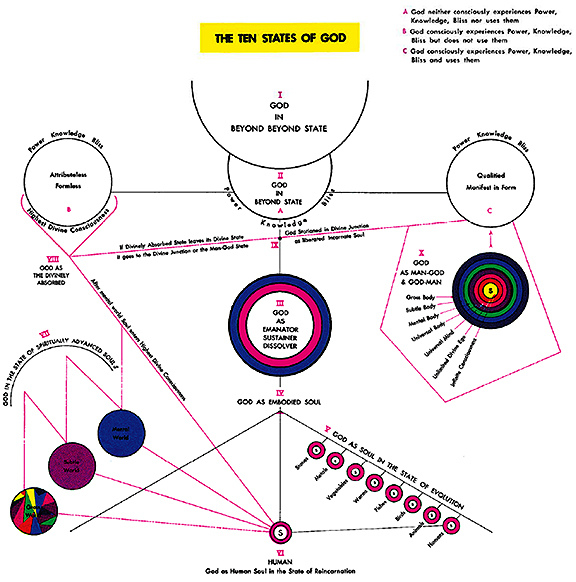
“The Ten States of God”
The spiritual dictum of Islamic
theology is “Huwal awwal, Huwal akher, Huwal zaher, Huwal
batin”
(He is the first, He is the last, He is the external, He is the
internal).
Maulana Shabistari, in Gulshan-e-Raz, says:
Gar andar amad avval ham bidar shud
Agar cih dar ma’ad az dar bidar shud.
“He returns to the door from which he first came out,
although in his journey he went from door to door.”
We shall now try to describe concisely each one of these ten
states of God as explained by Meher Baba.
State I
God in the Beyond-Beyond State
This state of God is so transcendent that nothing can really be
conceived of it. It is utterly pure and immaculate and has no tinge
of “otherness.” It is the hidden of all hidden knowledge and the
i n t e rnal of all internal realities. It is beyond all words and so it cannot
be adequately described. It is neither finite nor infinite, neither
attributeless nor with attributes. In this domain the wings
of thought, inference, discrimination and understanding are limp
and useless.
Bi Kiyal dar nagunjad, tuKiyal-i Kvud maranjan
Zi jahat buvad mubarra mavalab bihic suyash.
—Hafiz
“He cannot be grasped by the mind, therefore do not exert
yourself to understand Him; He is free of all directions,
therefore do not try to seek Him anywhere .”
Meher Baba says that when one who has realized this state of God
tries to describe it to others, this act results in a description not of the
first, but of the second state of God—God in the Beyond state.
It is the Eternity of all eternities (Azl-ul-Azal) because no eternity
can be conceived of to precede or to follow it. Here all indications blotted out ( Munqata-ul-Izharat), since no other thing exists that
can be pointed out or referred to. This pure essence (Zat-al-Baht) is
not aware of anything, even of itself.
This state has been referred to by the Sufis as Wara-ul-Wara—The
Beyond-Beyond state of God. Vedanta calls it Paratpar Parabrahma.
This is the state in which God is neither nirguna (attributeless)
nor saguna (with attributes), neither nirakar (formless) nor sakar
(with forms).
Of all the principal ten states of God, the first and the most original
state is the Beyond-Beyond state of God.
When there were no other states of God in the beyond the beginning
of the Beginning, only the most-original infinite state of
God (that is, “God-Is” state) prevailed as the Beyond-Beyond state
of God.
In the infinitude of this Beyond-Beyond state of God only the
infinity of Infinitude is manifest as the unbounded, absolute, infinite
Divine Vacuum; and all other states, attributes and aspects of
God, including infinite consciousness and infinite unconsciousness,
are all latent as the Nothing in that Infinitude of the unbounded, absolute,
infinite Divine Vacuum as the Everything (Everything also
includes the Nothing).
Thus, the most-original Beyond-Beyond state of God is that
state where one can only say: God-Is eternally; and that in this
most-original state, God is neither infinitely nor finitely conscious,
nor unconscious, of Self or of His own state of Infinitude. In this
state, God is also neither conscious nor unconscious of Illusion
or Reality.
State II
God in the Beyond State
We have already stated that the Beyond-Beyond state of God
can never be adequately described. God-realized beings, when
they t ry to describe the Beyond-Beyond state, succeed only in describing
the Beyond state of God, which is the Allah of Sufis, the
Ahuramazda of Zoroastrians, the Paramatma of Vedantists, God the
Father of Christians, and the Over-Soul of some philosophers.
The Almighty alone existed, but He was only latently conscious,
and hence He did not know Himself, and in the same way that consciousness
was latent in Him, so also Creation was latent in Him.
The difference between the latent and the manifest Creation
may be compared to that between a seed and a tree. But, whether
seed or tree, latent or manifest, Creation is always “no-thing,” because
it is the latent Nothing that is manifested as the Nothingness.
All that is latent as the Nothing in the Beyond State II of the
infinitude of God as the Everything is expressed and manifested
t h rough a most finite point in the infinitude of God. This point is
called the “creation point” or the “Om point.” Through this point
Creation has been precipitated. This creation point was also latent
in the most original State I of God, in the Beyond-Beyond state.
The process of emanating, sustaining and dissolving, which is
constantly and uniformly going on, may be illustrated by an analogy. Let us imagine that a human body is God. The human body
sleeping with eyes shut may then be compared to the Beyond state
of God, as State II–A. The very first moment of opening the eyes
may be compared to the state of God as Creator. The subsequent
condition of remaining awake may be compared to the state of God
as Sustainer, and going back to sleep again with eyes shut may be
compared to the state of God as Dissolver. Thus God is the Creator,
Sustainer and Dissolver, all three in One, at one and the same time.
State IV
God as Embodied Soul
Did apni thi use Kvahish
Ap ko har tarah bana dekha.
—Niyaz
“He desired to see Himself; hence He assumed to Himself
varied aspects involving names and forms.”
[See also Francis Brabazon, Stay with God ( Woombye, Queensland, Australia:
E dwards and Shaw for Garuda Books, 1959), 65–66. Ed.]
In order to understand how the infinitely unconscious state A of
God becomes gradually transmuted into the infinitely conscious state B of God and attains full and infinite consciousness, Meher
Baba gave the following analogy:
Imagine the infinitely unconscious God state A, before the
Creation came into being, as motionless infinite ocean. A puff of
wind then stirred the tranquil uniformity of this ocean, and immense
waves, countless drops of water, and innumerable bubbles
appeared from out of the uniformity of the limitless, infinite ocean.
The puff of wind that set the ocean into commotion may be compared to the impulse of the infinite, original urge-to-know originating
with the infinite, original whim of God, surging in God to
know Himself through His infinite God State II.
The stir on the surface of the ocean, caused by the infinite urge,
surcharged every drop of that infinite ocean with the infinite original
urge-to-know itself.
Thus Paramatma in His infinitely unconscious state A, being
urged to know Himself, simultaneously bestirs the tranquil poise
of every atma in Paramatma with an urge to know itself. This could
only be understood when Paramatma is compared to an infinite
ocean and the atmas to the drops of that infinite ocean. But it must
also be well noted that every drop of the ocean, when in the ocean,
is ocean itself, until the drops inherit individuality through bubble
formations over the surface of the ocean. Every bubble thus formed
would then bestow a separate and a particular individuality upon
every drop. And this created separateness would exist within the
uniform indivisibility of the drops of the infinite ocean as long as
these bubbles creating separateness exist. As soon as the bubbles
burst, the drops, which are and were already in the ocean itself, come
to realize that they are and were one with the infinite ocean; and they
gain this consciousness of their e t e rnal infinity in the infinite
ocean only after they first experience separateness and then dispel
the bubbles of ignorance that were instrumental in bestowing
upon them the experience of their apparent separateness from their
inherent indivisibility.
As long as the infinitely innumerable drops of the ocean do not
experience apparent separateness, they fail to realize their own
homogeneous and indivisible eternal, infinite existence as ocean
itself. It is only through the experience of apparent separatenessthat atmas can consciously realize their indivisible Oneness as
Paramatma.
In order to describe the God State IV of “God as Embodied
Soul,” let us think of one infinitely unconscious soul (atma) of Paramatma
in state A.
In the beginning, in state A, the soul (atma) has no consciousness
and has no impressions (sanskaras).
Therefore, at that stage and in that state the soul (atma) has no
gross form, gross body, subtle body nor mental body, because the
existence of gross, subtle and mental impressions (sanskaras )
only can give existence to gross, subtle and mental bodies; and
only the existence of these bodies can make possible the existence
of gross, subtle and mental worlds.
Hence in the beginning the soul in God state A, being infinitely
unconscious and being impressionless, had no consciousness of
gross, subtle and mental bodies, and was also unconscious of its
infinite Self. The soul naturally then had no experience of the
gross, subtle and mental worlds, and also had no experience of the
Over-Soul (Paramatma).
Now this infinite, impressionless, unconscious, tranquil state
of the soul reverberated with the first impulse, which we called The First Urge (the first urge to know Itself).
Simultaneously with reverberations of the first urge to know Itself,
a most - gross first impression emerged, objectifying the soul as
the absolutely opposite and most-finite counterpart of the absolutely
infinite Over-Soul.
The soul, being eternally in the Over-Soul and one with the
Over-Soul, has also the infinite potentialities of the Over- Soul,
though latent in its unconscious state. Thus the soul is also the
possessor of infinite power, knowledge and bliss.
Therefore, when the impressionless, infinite soul receives the
very first impression, this impression could be nothing other than
the most-gross impression, because the soul itself, which is the
possessor of infinite knowledge, tries to gain knowledge of its own
“Self.” This very conception on the part of the possessor of infinite
knowledge is infinitely crude or gross, and this infinitely crude or gross conception of the infinite soul imparted to the impressionless
soul the most-gross first impression. Simultaneously with the most gross first impression, the infinitely unconscious soul also gained
the most - finite first consciousness. With the increasing gross impressions, the consciousness evolved and the evolution of gross
forms gained momentum.
Consequently, the evolution of consciousness, the evolution
of gross forms and the evolution of the experiences of the gross
world were all effected as the result of the first urge of God to know
Himself.
Because of this most-gross first impression of the first urge, the
in inite, unconscious soul gained the aspects of experience for the
first time. This first experience of the infinite soul was that it (soul,
atma) experienced a contrariety (absolutely opposite by nature) in
its identity with the infinite, impressionless, unconscious state A of
Paramatma.
This experience of contrariety effected changeableness in the
eternal, indivisible stability of the infinite soul; and spontaneously
there occurred a sort of eruption, disrupting the indivisible poise
and unconscious tranquility of the infinite soul with a recoil or tremendous
shock, which impregnated the infinite unconsciousness
of the infinitely unconscious soul (atma ) with first consciousness
of its apparent separateness from the indivisible state of Paramatma.
But the soul being infinite, the first consciousness that it derived
from the recoil or shock of the absolutely opposite and most-gross
first impression of its separateness was naturally and necessarily
most-finite first consciousness.
The first consciousness gained by the soul was obviously most finite
in proportion to the experience of absolute opposites of its
own original, infinite state as in “A.”
Consequently, it then means that in the beginning when the
impressionless, infinite soul was first impressioned, such first impression was an absolutely most-finite gross impression. The first
consciousness it (soul, a t m a) derived was most finite. Naturally, at
that instant, the unconsciousness of the infinite soul actually experienced
a most-finite first consciousness of the most-gross first
impression.
Beams Beyond the Whim of God
The Whim from the Beyond
Through the ages, the human mind has been profoundly restless in its search for final explanations about first things. The history of these endeavors to grasp first things through the intellect is a tale of recurrent failures. The redeeming feature of these great efforts is that instead of being disheartened by the confessed failures of past thinkers, others are inspired to make fresh attempts. All these philosophical explanations are creations of the mind that has never succeeded in passing beyond itself. Thus they are confessed though inspiring failures; nonetheless each such failure is a partial contribution to knowledge of the Beyond. Only those who have gone beyond the mind know the Truth in its reality. If they sometimes explain what they know, which they rarely do, those explanations also being in words are limited but these words illumine the mind; they do not fill it with novel ideas.
The unitarian Beyond is an indivisible and indescribable infinity. It seeks to know itself. It is of no use to ask why it does so. To attempt to give a reason for this is to be involved in further questions and thus to start an unending chain of reasons for reasons, reasons for these reasons and so on ad infinitum. The plain truth about this initial urge to know itself is best called a whim (Lahar). A whim is not a whim if it can be explained or rationalized. And just as no one may usefully ask why it arises, so no one may ask when it arises. "When" implies a time series with past, present and future. All these are absent in the eternal Beyond. So let us call this initial urge to know a "whim." You may call this an explanation if you like or you may call it an affirmation of its inherent inexplicability.
The initial whim is completely independent of reason, intellect, or imagination, all of which are by-products of this whim. Reason, intellectand imagination depend upon the initial whim and not vice versa. Because the whim is not dependent upon reason, intellect or imagination, it can neither be understood nor interpreted in terms of any of these faculties of the limited mind.
The first whim to know instantaneously implies a duality, an apparent differentiation (not amounting to a breaking up) into two separate aspects, both of which are infinite as aspects of the Infinite. The first aspect is that of infinite consciousness and the second aspect is that of infinite unconsciousness. The duality strives to overcome itself and to restore the apparently lost unity: The infinite unconsciousness tries to unite with infinite consciousness. Both aspects are precipitated by the whim. This whim of the Infinite is in a way comparable to an infinite question, calling forth an infinite answer.
With the infinite question, there arises also the infinite answer. The infinite question is infinite unconsciousness; the infinite answer is infinite consciousness. But the infinite question and the infinite answer do not simply annul each other and relapse into the original unity of the Beyond. The two aspects have now descendedinto the primal duality which can resolve itself only by fulfilling the entire game of duality and not by any shortcut. The infinite unconsciousness cannot overlap on infinite consciousness; such coalescence is impossible.
To reach out towards infinite consciousness the infinite unconsciousness first has to fathom its own depths. It must experience itself first as infinitely finite, and gradually evolve into limited and limiting consciousness. With the evolution of the limited and limiting consciousness, there is also the evolution of the illusion which limits this limiting consciousness. The two processes keep pace with each other.
When the infinite unconsciousness tries to reach out to the infinite consciousness, the process is not instantaneous because of the infinite disparity between the two. The process takes an infinitely long time and eternity gets seemingly broken into the unending past, the transient present and the uncertain future. Instead of embracing the infinite consciousness in one timeless act the infinite unconsciousness reaches out towards it through a long-drawn-out temporal process of evolution, with all of its innumerable steps. It first attempts to fathom its own depths, then by backward treads it seeks and ultimately finds the infinite consciousness through numberless steps, thus fulfilling the whim from the Beyond.
The Fabric of the Universe
It is natural for the human mind to desire to know the general structure of the universe. It is also helpful to have a sort of chart of the universe in which one finds oneself. The fabric of the universe includes the spheres and the planes, and the different bodies with which a human soul is endowed.
The Wakeful States, Spheres, and Divine Natures
In Infinite
Intelligence and God Speaks
